How to Prevent Seasickness on a Cruise: 10 Effective Remedies
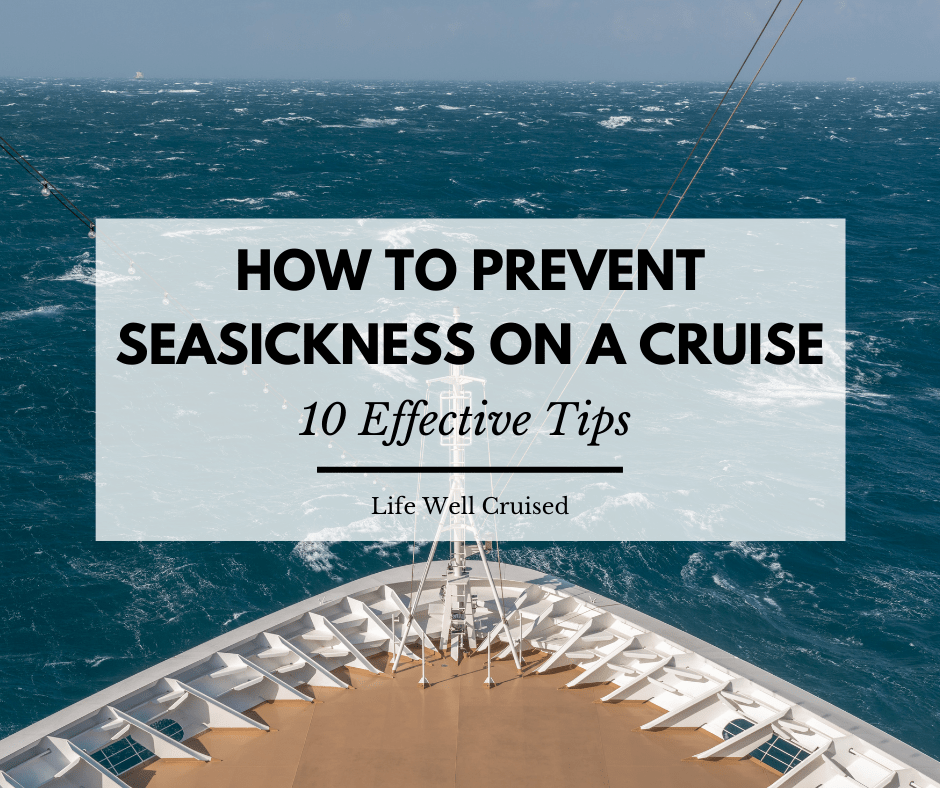
Sharing is caring!
If you’re going on a cruise and concerned that you might get seasick, you’re not alone. Asking “how to prevent seasickness on a cruise” , is one of the most common questions people have when planning a cruise.
After all, getting seasick really could ruin your vacation. While it’s less likely to happen on today’s large, modern cruise ships, I can tell you from personal experience, it does still happen.
The good news is that there are effective remedies for motion sickness, and these work very well on a cruise.
In this post, I share 10 ways to prevent, treat and ideally avoid seasickness altogether while cruising. I’ve included recommendations for seasickness medications, as well as natural remedies that really work.
As well, we’ll go through some frequently asked questions about how to manage seasickness on cruise ships. With these tips, you’ll be prepared to deal with the motion of the ocean, and prevail!

Seasickness on a Cruise

First, let’s go through what to expect if you do get seasick while on a cruise.
What are the symptoms of seasickness?
The symptoms of seasickness on a cruise can include feeling dizzy or having a headache. You may have also feel nauseous, have stomach cramps and even vomit.
For me, early symptoms of motion sickness include lightheadedness and a mild queasy feeling. I try and catch it at this early point, and after more than 20 cruises, this has worked for me.
The tips that I share below will help you to manage any seasickness symptoms.
Why does motion sickness happen on a cruise ship?
How come people get motion sickness on a cruise? Motion sickness happens due to repeated or continuous movement that affects our inner ear and sense of balance. As the cruise ship sails, some people can be affected by this motion.
Seasickness is another way to motion sickness, but on a cruise ship. You may also have heard the expression, “mal de mer”, which is French for sickness of the seas.
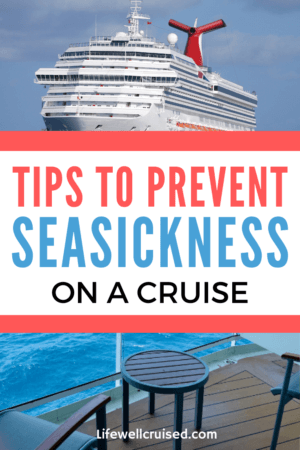
How likely are you to get seasick on a cruise ship?
Even though concerns about getting seasick on a cruise is a very common worry, especially for first time cruisers , most people will be fine. Modern cruise ships are built with stability and comfort in mind, and have stabilizers which are used, especially in rough seas.
However, you may feel some motion or slight vibration while on a cruise. I mention this as we were a bit surprised to find this out on our first cruise.
So many people said “you won’t feel the ship move” . They mean well, but on some cruises you’ll feel more movement then others, so it’s best to be prepared.
In some cases, the ship can hit rougher seas and high winds, and there will be some rocking. However, let me assure you that a large cruise ship will feel nothing like the movement on a small boat or even a ferry.
How to Prevent Motion Sickness on a Cruise
This post contains affiliate links which means if you click and buy that I may make a commission, at no cost to you. Please see my disclosure policy for details.
Life Well Cruised is a participant in the Amazon Services LLC Associates Program, an affiliate program designed to provide a means for sites to earn advertising fees by advertising and linking to Amazon.com.
One of the best ways to deal with seasickness on a cruise, is to prevent and avoid it if at all possible. These 10 seasickness prevention tips are ones that have worked for us, as well as many avid cruisers and crew.
1. Pick the right cruise cabin location
Before we get into what seasickness medications work best and some other tips and tricks, we should talk about cruise cabin locations.
To prevent seasickness, be sure that you choose the best stateroom location possible. If you’re new to cruising and unsure how you’ll feel, choose a mid-ship location.
These are the most desirable cabins because there will be less movement in the middle of the ship. Whether you choose an inside cabin , or a balcony cabin , try and choose a cabin that is as center as possible.
If a mid-ship cabin isn’t available, then opt for an aft cabin or mid-aft stateroom. If at all possible, try to avoid a forward cabin , as many cruise passengers report feeling more motion in this location.
A travel agent can help you to pick the best cabin for you, and look out for any other cabins to avoid .
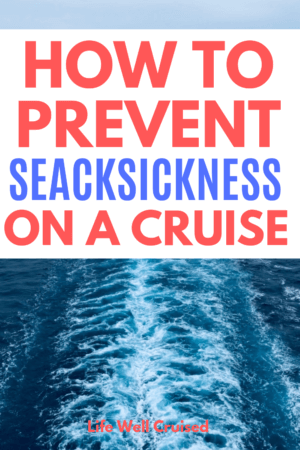
2. Pick a “calm” cruise itinerary
While the seas can be unpredictable, there are some cruise itineraries that generally have calmer seas, than others. If you’re concerned about getting seasick, avoid trans-Atlantic crossings and other itineraries where the seas can be fierce.
Your travel agent will be able to help you navigate the possibilities (pun intended), as a rule of thumb, the Western Caribbean and the Gulf of Mexico tend to have more stable seas.
3. Green Apples

Would you like to know a cruise tip that really works to get over seasickness on a cruise? Eat a granny smith or green apple.
This has long been a favorite crew and passenger tip. In our experience, it really does help.
Often, eating a green apple will settle the stomach if you start to feel nauseous due to seasickness. Apparently, the pectin in green apples helps to neutralize acid in the stomach, and the natural sugar helps settle the stomach
You’ll find green apples in the buffet, so it’s a good idea to take a couple back to your room, in case you need them later on in the cruise.
4. Ginger candies

Another natural remedy for dealing with motion sickness while cruising is ginger. If you don’t want to eat raw ginger, you can buy ginger candies or even dried, sugar coated natural ginger.
Some cruise lines, such as Cunard , even give out ginger in the evening with dinner when the seas are rough.
While I prefer not to eat raw ginger, I always bring some ginger candies and usually find them very effective in preventing seasickness before it starts.
Recommended: Ginger candies – organic and gluten free (Amazon)
5. Bonine or Dramamine

An over the counter medication like Bonine or Dramamine, can be highly effective to deal with symptoms of seasickness, so you can enjoy your cruise.
In our experience, worked very well, alleviating seasickness symptoms without drowsiness.
Make sure to bring a pack or two your toiletry bag or cruise first aid kit . This way, if you need it you won’t have to hope the shop is still open on the cruise ship.
Recommended: Bonine Motion Sickness prevention tablets (see Amazon reviews & price here)
6. Seabands

A favorite cruise essential for many, seabands are wristbands that alleviate motion sickness symptoms. They work with acupressure buttons to prevent symptoms of seasickness and many cruisers have very good results. Seabands are natural and contain no medication, plus, they’re reusable.
If you think that you may be prone to motion sickness, it’s a good idea to take along seabands for both adults and children , in case.
Recommended: Seabands (check on Amazon for variety packs)
7. Motion Sickness Patch/Scopolamine
If you’re prone to motion sickness, scopolamine patches, which are placed behind the ear, are very effective in preventing seasickness.
They are a preventative treatment, and should be used ideally before symptoms begin, and need to be changed every 3 days. They may only be available by prescription, so talk with your doctor to see if they’re right for you.
There are also non-prescription seasickness prevention patches available, that many use and find effective. Check out the information and reviews to learn more.

8. Acupuncture
Another preventative treatment for motion sickness on a cruise is acupuncture . An alternative treatment, it’s effectiveness isn’t conclusive. Anecdotal reports suggest many patients have had good results.
My mother-in-law, who also suffers from vertigo periodically, uses acupuncture before she goes on a cruise. I’ve been on cruises with her, and have seen how it definitely worked for her. She was well and unaffected, even while others were swaying and turning green during an evening of very rough seas.
If you already use acupuncture, you may want to ask your practitioner if he or she thinks it will help to prevent seasickness on your cruise. As always, please do check with your physician.
9. Keep hydrated
It may sound simple, but keeping hydrated by drinking a lot of water will help prevent feelings of seasickness. While on a cruise you may be getting too much sun and even drinking too many alcoholic drinks, which can lead to becoming dehydrated.
By keeping hydrated, your body will be at it’s best and less prone to nausea, headaches, dizziness and upset stomach. It’s also helpful to avoid very fatty or spicy food.
Cruise tip – Bring along a refillable water bottle , to stay hydrated on your cruise.
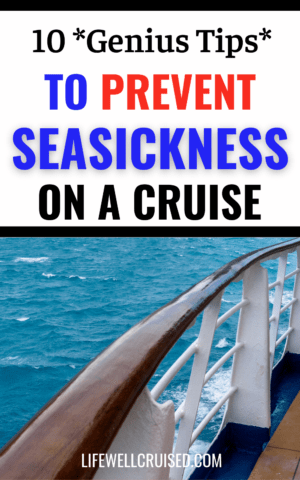
10. Get fresh air
If you suddenly start to feel unwell, with symptoms dizziness and nausea, try and get fresh air as soon as possible. A good place to sit is on the Lido deck, near the mid-ship pool. This location, in the open space and with a sea breeze, is probably the best place to grab a green apple and wait for symptoms to subside.
There is also advice to look at the horizon. This may work for some, however in our experience, if there are large waves, this may do more harm than good.
A word of caution – often taking medication to remedy or even prevent motion sickness symptoms as soon as they start is most effective.
Best Motion Sickness Medication for a Cruise
As a recap, these are the most effective and recommended seasickness medications and natural remedies for a cruise (all Amazon links).
Seabands (for adults)
Seabands (for children)
Dramamine (long lasting nausea relief)
Dramamine for kids (see choices on Amazon)
Ginger candies
Motion sickness patches
Watch our YouTube video below for more tips on preventing seasickness while cruising
Recap: How to Prevent Seasickness on a Cruise
A common concern for new cruisers, is how to avoid and prevent getting seasick on a cruise. In this post, we went over what to expect on a cruise, and how likely it is to feel symptoms of motion sickness on a modern cruise ship.
We also shared 10 effective tips for preventing and dealing with seasickness on a cruise. The remedies include both seasickness medication and natural remedies, that have been shown to be useful and helpful for cruisers.
Don’t forget to pack some seasickness medication or prevention treatments to bring along on your cruise vacation.
Have you ever been seasick on a cruise? What tips, medications or treatments did you find worked best?
Happy cruising!
P.S. If you enjoyed this post and found it helpful, please don’t keep it to yourself ;-). Please share on Facebook or PIN to your favorite Pinterest board (share buttons at the top). Thanks so much!
What to Pack for a Caribbean Cruise
31 Cruise First Aid Kit Essentials You Need to Have
What Toiletries to Pack for a Cruise (packing list)
25 Cruise Essentials Most Popular on Amazon
21 Things People Forget to Pack for a Cruise (and regret)
30 Cruise Cabin Hacks Every Cruiser Needs to Know
Let’s connect:
Follow me on Facebook at Life Well Cruised
Follow me on YouTube at Life Well Cruised (Vlogs and cruise tips)
Follow me on Pinterest at Life Well Cruised
Follow me on Instagram at Life Well Cruised
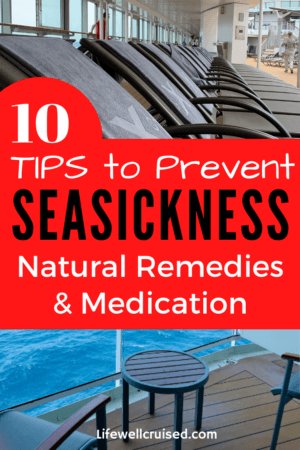
15 Comments
I read this article prior to going on a cruise to the Bahamas and found some of these tips very helpful. When searching for an acupressure band I came across NoMo Nausea at CVS. It is an silicone acupressure wristband that is infused with peppermint essential oils. I have tried sea bands before and while they provided slight nausea relief for me, I found the peppermint scent combined with the acupressure to work more effectively when reducing my sea sickness. Hope this helps for others who also experience seasickness!
Hi Juliette,
Firstly, thanks so much for reading this and then taking the time to come back and add your suggestion. That’s really interesting – I’ll have to keep an eye out for a seaband combined with that scent.
I’m sure your personal suggestion will be helpful to someone.
Hope you enjoyed your cruise!
Hello! Thank you for all the great information.. Another thing that helps with seas sickness is lime. Slicing and smelling the lime really works. I learned this on a snorkeling trip in Mexico. I want feeling well from all the bobbing in the water and was given lime by the locals and in a short time I was feeling myself again. On my last cruise I asked my waiter to bring me lime slices as the dining room was in the front of the ship and soon the entire table was enjoying the lovely sent of lime and feeling great!
Thanks so much for this! Great info!
Glad the info was helpful Becky. Have a great cruise!
- Pingback: What You Need to Know if You're Cruising Out of South Florida - Coastlines to Skylines
I love using Motioneaze oil. You rub it behind your ear and it really works! Expensive on the ship but not too bad on Amazon or at CVS.
Thanks Tricia. I’ve never heard of it or used it, but that sounds great.Great tip to pre-buy rather than get it on the ship.
I appreciate you taking the time to comment 🙂
Ilana and Tricia – I experienced fairly serious motion sickness on our 2nd sea day — I wasn’t the only one, as the ship staff stocked those “special bags” everywhere.. Nevertheless, I was wearing seabands, I took Dramamine; tried all sorts of remedies and preventives; and nothing worked all day until my friend gave me Motioneaze. Within minutes of applying this behind my ears, I felt immensely better. (It’s possible that the seas were finally calming by then!). Thank you for great posts!!!
Thanks for sharing the recommendation!
Tricia,, I have never heard of this, going to check it out. Thanks so much!
My understanding is that it is good to look at horizon so your eyes and ears “agree”. It works for me.
That’s awesome and good advice. That works for me, but my husband will feel more sick. I have a feeling it’s because the wobbly feeling has already set in.
Thanks Patty for the comment – I know it will be helpful to others 🙂
Dramamine now makes a “Non-Drowsy Naturals” version of their motion sickness pills. I have always found that regular Dramamine and Bonine make me feel very sleepy (even the non-drowsy formulas). However, I was able to take the Dramamine Naturals version (made with ginger) and it worked just as quickly on the motion sickness and did not make me drowsy at all.
That’s great to know Melissa. Thanks so much for sharing how well this worked for you. I love ginger so perhaps I’ll try it next cruise 🙂
Leave a Reply Cancel reply
Your email address will not be published. Required fields are marked *
This site uses Akismet to reduce spam. Learn how your comment data is processed .
This is the announcement bar for Poornima to test the Close Button. It will expire May 31 2024.
- Pre-Cruise FAQ
- Onboard FAQ
- Post-Cruise FAQ
- Cruisetours FAQ
- Special Offers Sign Up
- Cruise Deals
You have been logged out
Your window will update in 5 secs
Best Motion Sickness Medicine for a Cruise
The best motion sickness medicine for cruises will be different for everyone. All our ships are well-stabilized and bear plenty of weight so most guests don’t even feel like they’re moving. That said, certain guests may be more prone to feeling motion than others — like they would in a car or plane. While some find relief with devices like patches and wristbands, others prefer drinking water and getting fresh air. Here are some of the best remedies for tackling motion sickness on a cruise.
Bring Nausea Relief
If you’re more sensitive to motion sickness on cruises, stay prepared with store-bought solutions. Some of the most popular products include skin patches and wristbands. Patches are typically placed behind your ear where the medication can more easily absorb into your skin. Since the patches are hidden, you don’t have to worry about them distracting from your dinnerware wardrobe or photos from your shore excursions. Similarly, the bands are worn on the wrist and target pressure points to help stabilize your body. These products are usually waterproof so no need to remove them before enjoying the pools on board.
According to many of our guests, some of the best seasickness tablets for a cruise include Dramamine or Bonine. These medications can be taken before nausea arises to help lessen the severity. They may also be taken to ease the feeling of sickness as it occurs. Be aware that these may cause drowsiness in some guests. Please consult a medical professional to determine whether this is the best solution for you. Whether you want to prevent nausea or help alleviate it in the moment, considering adding all of these therapies to your cruise packing list and stay prepared for any situation.
Step Outside for Fresh Air
One of the easiest ways to relieve nausea while on board is stepping outside to get fresh air. That’s why we recommend booking a room with a balcony to guests who are more prone to feeling motion sickness. Slip outside at any time of the day from the comfort of your stateroom. Or, lie down on your lounge chair undisturbed by other guests. Focus on the refreshing breeze and before you know it you’ll be ready to dive back into onboard activities.
Drink Plenty of Water
Sometimes, a glass of water is the only relief you need. Many guests have shared that regularly drinking H2O during the day helped keep nausea at bay. Whether you’re relaxing poolside or grabbing a slice of the best pizza at sea, there are always refreshments nearby. If you don’t know where to go, just find one of our friendly crew members who will be happy to assist you.
Visit the Lotus Spa®
For the ultimate remedy, retreat to the Lotus Spa® , where skilled therapists can relieve any maladies. Upon visiting the spa, let our staff know what symptoms you’re experiencing and they can recommend the best treatment for you. Experience the healing powers of acupuncture which can precisely target pressure points. Indulge in a relaxing massage to help soothe areas of tension. Or, treat yourself to a hydrating facial and let the feelings of nausea wash away.
All our ships were designed to deliver seamless voyages to every destination. If you’re prone to feeling motion sickness on a cruise, don’t let that get in the way of your world travels. Stay prepared with the best medication for seasickness on a cruise and set sail with Princess.
- Skip to primary navigation
- Skip to main content
- Skip to primary sidebar
- Skip to footer
TravelAwaits
Our mission is to serve the 50+ traveler who's ready to cross a few items off their bucket list.
How I Finally Discovered A Seasickness Cure That Lets Me Take Cruises

- Cruises and Sailing
- Destinations
- News and Tips
- Travel Tips
- Types of Travel
To say I get seasick very easily is a sick understatement.
I’ve gotten seasick on a 2,000-passenger cruise ship in the Caribbean. I’ve gotten sick on the 100-car auto-ferry that putters sturdily from Lewes, Delaware, to Cape May, New Jersey. I got sick while snorkeling on gentle waves in Baja Mexico, on both a Jetski and a pontoon boat on a tiny lake in Michigan, and even, somehow, while rocking silently in a motor boat roped to a dock.
But I have never vomited. Instead, I become nauseated and disoriented and I simply shut down, withdrawing from any contact or activity with my fellow travelers. I disappear into an exquisitely uncomfortable, dizzy isolation. I am light-headed, inert, and lame-brained.
The symptoms seemed so strange — so different from the toilet-hugging episodes others report — that I began to wonder if this was actually motion sickness at all, or just some idiosyncratic behavioral response to waterborne travel: I hate being here, go away.
But a detailed summary published by the National Library of Medicine validates my experience. For some, motion sickness “may appear to untrained observers as apathy, boredom, irritability, and personality changes.” In more severe cases, it says, one symptom can be “social isolation.”
On the Mexico snorkeling trip, a friend saw how I was behaving and thought my wife and I had gotten into a terrible argument.
It would be so much easier to just puke and be done with it.
Why Motion Sickness Happens
Nearly everybody is susceptible to motion sickness in extreme cases. Friends who have taken small-ship cruises to Antarctica through hellish storms report that nearly all the guests were curled in their beds, with buckets at their sides.
Habituation can reduce the effects, which explains why the crews of those Antarctic ships empty the guests’ buckets instead of filling them themselves. But most of us are not on the water in rough conditions often enough to get used to it.
To oversimplify, motion sickness occurs when the various systems in your body responsible for balance — your inner ear, eyes, bones, and muscles — are in conflict with each other. Let’s say you’re just sitting at a café on the middle deck of a mega cruise ship the size of an aircraft carrier. Your body feels stable. The surface of your cappuccino is placid. You have no view of the sea. But your inner ear registers subtle motion.
This conflict of inputs leads to a cascade of physiological actions, with alarm signals rushing through your brainstem, thalamus, and cortex, finally reaching the vomiting center and resulting in a powerful nausea.
Yes, medical sources call it the “vomiting center.”
What I’ve Tried For Sea Sickness
Because my strong tendency to motion sickness restricts my travel choices, I have diligently tried everything said to work by many others.
- Dramamine, Bodine, Marezine: All are powerful, widely available antihistamines. They knock me out. Worse, they provide little relief.
- The Transderm Scop patch: Widely considered the medical intervention that best balances positive benefits and negative side effects, it’s a prescription patch you wear behind your ear. I gave it a try on a cruise. It helped a bit on calm western Caribbean waters. But the patch made me dizzy and drowsy.
- Ginger ale, ginger candy, ginger supplements: Nope.
- Acupressure wrist bands: You must be kidding.
What Finally Cured My Motion Sickness
Recently, a friend and her new boyfriend Dean — a proud open-water sailor and owner of a 37-foot sailboat he keeps not far from Annapolis, Maryland — invited my lovely wife and me for an afternoon on the Chesapeake Bay.
We wanted to accept the social invitation. Winds were expected to be light, around 10 mph according to the National Weather Service, with waves up to 3 feet.
I told Dean about my delicate constitution, and he said, conspiratorially: Don’t worry, I’ve got you covered.
He assured me he had a medication all sailors use in Europe, the Caribbean, Mexico, and the Mediterranean — everywhere he sails. In most places, it’s available over the counter. While it’s an antihistamine, it doesn’t make you drowsy. Nobody Dean knows bothers with other treatments. It’s the go-to drug for the British Royal Navy.
The drug is called Stugeron, known generically as cinnarizine .
About half an hour before we motored away from the dock, he handed me a plastic-and-foil blister pack. Take one 25 milligram pill, he said. I did.
Miraculously: It worked.
For the first time, I was able to enjoy the water like a normal person. We spent a couple of hours rockin’ around the bay. I realize waves of 3 feet are not rough seas, but they were more than enough to have sent me unprotected into a stupor. Throughout, I was symptom-free. I was able to run ropes through pulleys and fasten them to cleats and so forth.
I was able to feel the breeze on my face and tug my hat against the wind, enjoying the view, the spray, and yes, even the constant bobbing up and down. The monster wakes generated by distant cargo ships didn’t faze me a bit.
Getting Your Hands On Stugeron
The FDA has stubbornly refused to approve Stugeron for sale in the U.S. This is because Stugeron is a calcium channel blocker. Those who take blood pressure medicine recognize this kind of drug can, in rare cases, lead to low blood pressure. The FDA ruled that this exposes too many people to risk allowing its use, even under a doctor’s supervision.
Many other nations’ medical agencies disagree. I am no doctor or medical expert, so I leave it to others to figure out if the FDA is right and everybody else is wrong, or vice versa.
But all this means my new sailing buddy Dean and I simply need to order Stugeron by mail from a Canadian pharmacy. (If you are at risk of low blood pressure, I recommend you educate yourself further before doing so.)
I placed an order. The pills arrived without incident. I feel like a new world of travel opportunities is open to me.
A gourmet small-ship cruise of the Baltic! A remote snorkeling adventure in Australia! A journey among the Greek islands! A small-ship voyage to Antarctica? Who knows?

They live in Bethesda, Maryland, not too far from their two boys, who are both married and fully launched.

After Cruise Motion Sickness: Causes, Symptoms, and Treatment Options

Do you ever feel like you’re still on a cruise ship even after you’ve returned home? Do you experience symptoms such as dizziness, nausea, and a rocking sensation that just won’t go away?
If so, you may be suffering from a condition known as mal de debarquement syndrome (MdDS).
MdDS is a rare motion disorder that affects some people after they disembark from a boat or ship. Symptoms can persist for days, weeks, or even months after the cruise has ended, making it difficult for sufferers to resume their daily activities.
While the exact cause of MdDS is not fully understood, it is believed to be related to a mismatch between the brain’s perception of motion and the body’s actual movement.
Fortunately, there are ways to manage the symptoms of MdDS and get your land legs back. From medication to natural remedies, there are various options available to help alleviate the discomfort associated with this condition.
In this article, we will explore the causes and MdDS symptoms, as well as the most effective treatments for after-cruise motion sickness.
Understanding Motion Sickness

The inner ear, also known as the vestibular system, is responsible for maintaining your body’s sense of balance and orientation. When you are in motion, the vestibular system sends signals to your brain to help it understand your body’s position and movement.
However, if your eyes see something different from what your inner ear is sensing, it can cause a conflict in your brain, leading to motion sickness.
After cruise motion sickness (aka land sickness) can affect anyone, but some people are more susceptible to it than others. Women, children under 12, and people with a history of migraines or inner ear problems are more likely to experience this balance disorder.
Symptoms include nausea, vomiting, dizziness, sweating, and fatigue. These symptoms can be mild or severe and can last for minutes or hours, depending on the severity of the motion sickness.
To prevent land sickness, it is important to avoid activities that can trigger it, such as reading while in motion or sitting in the backseat of a car. It is also helpful to keep your eyes fixed on a stable object, such as the horizon, and to avoid looking at moving objects.
If you do experience such symptoms, there are several remedies that can help alleviate the nausea. These include taking over-the-counter medications, such as antihistamines or ginger supplements, and practicing deep breathing and relaxation techniques.
Specifics of After Cruise Motion Sickness
After a cruise, it’s common to feel like you’re still on the ship for a short period of time. This feeling is known as “sea legs” and is caused by your brain still adjusting to being back on land.
However, for some people, the symptoms of motion sickness can persist for days or even weeks after the cruise has ended. This is known as after cruise motion sickness or mal de debarquement syndrome (MDDS) .
MDDS is a rare condition that affects a small percentage of people who have been on a cruise. The symptoms of MDDS can include a persistent feeling of rocking or swaying, dizziness, nausea, and fatigue. These symptoms can be mild or severe and can last for days, weeks, or even months.
The exact cause of MDDS is unknown, but it is believed to be caused by a mismatch between the signals that your brain receives from your inner ear and your eyes. This mismatch can cause your brain to continue to perceive motion even when you are stationary, leading to the symptoms of MDDS.
If you are experiencing symptoms of MDDS after a cruise, it’s important to seek medical attention. Your doctor may be able to recommend treatments such as medication or physical therapy to help alleviate your symptoms.
It’s also important to take steps to prevent MDDS before and during your cruise. This can include taking medication to prevent motion sickness, staying hydrated, and avoiding alcohol and caffeine. Additionally, during the cruise, you can try to stay in the middle of the ship, where there is less motion, and avoid looking at the ocean or other moving objects.
Symptoms of Land Sickness
If you have ever experienced motion or land sickness, you know how uncomfortable it can be. The symptoms can vary from person to person, but some common symptoms include:
These symptoms can last for hours or even days, depending on the severity of your motion sickness. In some cases, you may experience migraines or headaches as well.
One of the most common symptoms is imbalance. You may feel like you are swaying or rocking, even when you are standing still. This can make it difficult to maintain your balance and can lead to falls.
In addition to imbalance, you may also experience tiredness and fatigue. This can make it difficult to focus and can affect your overall mood. Some people even experience depression as a result of their motion sickness.
If you are experiencing any of these symptoms, it is important to take steps to manage your motion sickness. This may include taking medication, avoiding certain foods or activities, or using relaxation techniques to reduce anxiety.
How to Prevent Land Sickness After Your Cruise

While there is no foolproof method to prevent land sickness, you can take certain steps to help minimize its effects:
- Gradual Adjustment: Give your body time to readjust to the stable ground. Avoid making sudden movements and take it easy during the first few days after disembarking from the cruise ship.
- Stay Hydrated: Drink plenty of water to stay hydrated, as dehydration can worsen the symptoms of land sickness.
- Get Adequate Rest: Allow your body to recover from the physical and sensory changes experienced during the cruise. Get enough sleep to aid in the readjustment process.
- Avoid Stimulants: Limit the intake of caffeine, alcohol, and other stimulants that can disrupt your body’s natural equilibrium.
- Focus on the Horizon: When walking or standing, try to focus on the horizon or a stable object in the distance. This can help your brain reorient itself and reduce the sensation of movement.
- Avoid Prolonged Screen Time: Minimize excessive screen time, such as watching TV or using a computer, as this can exacerbate symptoms.
- Motion Exercises: Gentle motion exercises, like rocking or swaying slowly while sitting or standing, might help your body adapt to the changes.
- Balance Training: Engage in simple balance exercises, like standing on one leg or walking in a straight line, to improve your body’s balance mechanisms.
- Deep Breathing and Relaxation Techniques: Practicing deep breathing and relaxation exercises can help reduce stress and alleviate symptoms.
- Consult a Healthcare Professional: If the symptoms persist or become severe, consult a healthcare professional experienced in treating motion-related issues or vestibular disorders.
It’s important to remember that land sickness usually resolves on its own within a few days to a few weeks. However, if the symptoms persist for an extended period or interfere with your daily life, it’s best to seek medical advice.
As with any medical condition, individual responses may vary, and the effectiveness of preventive measures can differ from person to person.
If you are concerned about land sickness or have any underlying health conditions, consult a healthcare professional for personalized advice and guidance
Preventing Motion Sickness on Your Cruise
If you’re planning a cruise, you may be worried about getting motion sickness. Fortunately, there are several ways to prevent it.
Choose Your Cabin Wisely
When booking your cabin, try to choose one in the middle of the ship. This is the most stable area of the ship and will experience the least amount of movement. Additionally, cabins that are located on lower decks tend to experience less motion than those on higher decks.
Take Advantage of Stabilizers and Hull Design
Modern cruise ships are equipped with stabilizers that help reduce the amount of rolling and pitching. Additionally, the hull design of newer ships is optimized to reduce motion. When booking your cruise, try to choose a newer ship that has these features.
Look at the Horizon
When you’re on the ship, try to focus on the horizon. This can help reduce the feeling of motion sickness. Avoid looking at anything that is moving, such as the waves or other passengers.
Avoid Reading
Reading while on a moving ship can make motion sickness worse. If you’re prone to motion sickness, try to avoid reading while on the ship.
Get Fresh Air
If you’re feeling queasy, try to get some fresh air. Go outside on the deck and take deep breaths. This can help you feel better.
Avoid Windy Areas
Windy areas of the ship can exacerbate motion sickness. Try to avoid areas where there is a lot of wind.
Medications
If you’re prone to motion sickness, talk to your doctor about medications that can help prevent it. There are several over-the-counter and prescription medications that can be effective. However, be aware that some medications can cause drowsiness.
Motion Sickness Medications

Meclizine is an over-the-counter medication that come as motion sickness pills. It is an antihistamine that works by blocking the effects of histamine, a chemical in the body that can cause nausea and vomiting. Meclizine is available in tablet form and should be taken at least one hour before traveling.
Scopolamine is a prescription medication that is available in patch form. It is a type of anticholinergic medication that works by blocking the effects of acetylcholine, a chemical in the body that can cause nausea and vomiting. The patch should be applied behind the ear at least four hours before traveling and can be effective for up to three days.
Dramamine is an over-the-counter medication that can be used to treat motion sickness. It contains the active ingredient dimenhydrinate, which is an antihistamine that can help alleviate nausea and vomiting. Dramamine is available in tablet or liquid form and should be taken at least 30 minutes before traveling.
It is important to note that these medications can cause drowsiness as a side effect, so it is recommended that you avoid driving or operating heavy machinery while taking them.
Additionally, some medications may interact with other medications you are taking, so it is important to speak with your healthcare provider before taking any new medication.
Natural Remedies for Motion Sickness
If you’re looking for natural remedies to help ease your motion sickness after a cruise, there are several options to consider. These remedies can help alleviate symptoms like nausea, dizziness, and vomiting.
One of the most popular natural remedies for motion sickness is ginger. Ginger has been used for centuries to treat nausea and vomiting, and studies have shown that it can be effective in reducing symptoms of motion sickness as well. You can try drinking ginger tea or taking ginger supplements to help alleviate your symptoms.
2. Fresh Air
Another natural remedy is fresh air. When you’re feeling nauseous or dizzy, getting some fresh air can help provide relief. If possible, step outside onto the deck of the ship or open a window in your cabin to get some fresh air.
3. Acupressure Bands
You may also want to try using acupressure bands. These bands apply pressure to certain points on your wrist that are believed to help alleviate nausea and vomiting. They are safe, easy to use, and can be found at most drugstores.
4. Peppermint
Peppermint is another natural remedy that can be effective in reducing symptoms of motion sickness. Peppermint has a calming effect on the stomach and can help alleviate nausea. You can try drinking peppermint tea or using peppermint essential oil to help ease your symptoms.
5. Green Apples
Green apples are believed to help with motion sickness due to their natural acidity and fresh aroma. Green apples have a slightly higher level of acidity than other apple varieties. Some people claim that the acidity can help neutralize stomach acids, reducing feelings of nausea and discomfort associated with motion sickness. (I got ill on a cruise one time from large waves and I ate half a green apple with some sprite and within 20 min I was feeling much, MUCH better).
6. Alcohol Pads
Smelling alcohol pads for nausea is a home remedy that some people use to try and alleviate feelings of nausea. The idea behind this practice is that the strong scent of the alcohol might help to distract from or mask the sensation of nausea. Additionally, some believe that the alcohol’s volatile compounds could have a calming effect on the stomach.
If you’re looking for a medication that is considered natural, you may want to consider Bonine. Bonine is an over-the-counter medication that contains meclizine, an antihistamine that can help alleviate symptoms of motion sickness. It is considered safe and effective for most people.
8. Acupuncture
Finally, acupuncture is an alternative therapy that can be effective in reducing symptoms of motion sickness. Acupuncture involves the insertion of thin needles into specific points on the body, and it is believed to help promote balance and alleviate nausea and vomiting.
Tips for Traveling with Motion Sickness
Motion sickness can be a real bummer when you’re traveling, especially after a cruise vacation. But don’t let it hold you back from exploring the world. Here are some tips to help you manage motion sickness while traveling:
Choose the Right Mode of Transportation
Some modes of transportation can trigger motion sickness more than others. If you know you’re prone to motion sickness, try to avoid cars, buses, and trains that have a lot of sudden stops and starts. Instead, opt for a cruise ship or plane, which tend to have smoother rides. If you’re traveling by car, try to sit in the front seat and focus on the road ahead.
Choose the Right Seat
When traveling by plane or cruise ship, try to choose a seat near a window or with access to fresh air. Being able to see the horizon can help with motion sickness, and fresh air can help alleviate symptoms. If you’re on a cruise ship, consider booking a stateroom with a balcony so you can step outside whenever you need to.
Pack the Right Supplies
There are several over-the-counter medications and natural remedies that can help with motion sickness. Ginger, for example, has been shown to be effective in reducing nausea and vomiting. You can take ginger supplements or bring ginger tea or candies with you on your trip. Other options include acupressure wristbands, which apply pressure to a specific point on your wrist to help alleviate symptoms, and over-the-counter medications like Dramamine.
Take Breaks
If you’re on a long trip, make sure to take breaks and get some fresh air whenever possible. Take a walk around the plane or cruise ship, or step outside for a few minutes if you’re traveling by car. Taking breaks can help reset your senses and alleviate motion sickness symptoms.
By following these tips, you can manage motion sickness and enjoy your travels without feeling sick. Remember, everyone’s experience with motion sickness is different, so it’s important to find what works best for you.
Specific Groups Affected by Motion Sickness
Motion sickness can affect anyone, regardless of age or gender. However, some groups may be more prone to motion sickness than others. Here are some specific groups that may be affected by motion sickness:
Studies have shown that women are more likely to experience motion sickness than men. This may be due to hormonal differences, as women’s levels of estrogen and progesterone fluctuate throughout their menstrual cycle. These hormones can affect the vestibular system, which is responsible for maintaining balance and spatial orientation.
Middle-aged Women
Middle-aged women are particularly susceptible to motion sickness, especially during the perimenopausal and menopausal periods. This is because hormonal changes during this time can disrupt the vestibular system, making it more sensitive to motion.
Pregnant Women
Pregnant women may experience motion sickness due to hormonal changes, increased sensitivity to sensory stimuli, and changes in balance and coordination. Additionally, many anti-motion sickness medications are not safe for pregnant women to take, so it’s important to talk to your doctor before taking any medication.
Children are also prone to motion sickness, especially those between the ages of 2 and 12. This is because their vestibular system is still developing, and they may not have fully developed their ability to suppress conflicting sensory information.
In general, anyone can experience motion sickness, but some groups may be more susceptible to it than others. If you fall into one of these groups, it’s important to take preventative measures to avoid motion sickness, such as sitting in the front of a car or boat, focusing on a fixed point in the distance, and avoiding reading or looking at screens while in motion.
Diagnosing Land Sickness
If you are experiencing symptoms of land sickness after a cruise, it is important to seek medical attention from a doctor or medical professional. Your doctor will begin by taking your medical history and performing a physical exam to check for any underlying conditions that may be contributing to your symptoms.
In some cases, your doctor may refer you to a neurologist, who specializes in disorders of the nervous system. They may also order blood tests or a hearing exam to rule out other possible causes of your symptoms.
One way that doctors diagnose motion sickness is by evaluating your internal models. These are the mental representations that your brain uses to predict how your body will move and react to different stimuli. When your internal models are disrupted, such as when you are on a moving ship, it can lead to symptoms of motion sickness.
Your doctor may also use a variety of other diagnostic tools to help diagnose your condition. For example, they may use a computerized dynamic posturography (CDP) test to evaluate your balance and stability. This test involves standing on a platform that moves in different directions while sensors measure your body’s response.
Dealing with Severe Motion Sickness

One effective treatment is vestibular rehabilitation. This therapy involves exercises that help you retrain your brain to process the signals it receives from your inner ear, which can help reduce your symptoms.
Your doctor may refer you to a physical therapist who specializes in vestibular rehabilitation to help you develop a personalized treatment plan.
Another condition that can cause persistent motion sickness is Mal de Debarquement Syndrome (MDDS). If you have been diagnosed with MDDS, your doctor may recommend medication to help manage your symptoms. Antidepressants and anti-anxiety medications can be effective in reducing the severity of your symptoms.
In addition to medication and therapy, there are other steps you can take to manage your motion sickness.
Here are a few tips that may help:
- Avoid reading or looking at screens while in motion
- Focus on a fixed point in the distance to help stabilize your vision
- Stay hydrated and avoid alcohol and caffeine
- Get plenty of rest and avoid overexertion
By taking these steps and working with your doctor to develop a treatment plan, you can manage your severe motion sickness and improve your quality of life.
Lifestyle and Motion Sickness
Motion or land sickness can be a frustrating and debilitating condition that can impact your daily life, especially after a cruise. While there is no guaranteed cure, there are several lifestyle changes and remedies that can help alleviate symptoms.
Regular exercise can help reduce the severity of motion sickness symptoms. Exercise increases blood flow and can help improve balance and coordination. However, it is important to avoid exercising immediately before or after a cruise, as this can exacerbate symptoms.
Getting enough rest before and after a cruise can help reduce the likelihood and severity of motion sickness. Lack of sleep can make symptoms worse, so it is important to prioritize rest and relaxation.
Dehydration
Dehydration can worsen motion sickness symptoms, so it is important to stay hydrated before, during, and after a cruise. Drinking plenty of water and avoiding alcohol and caffeine can help prevent dehydration and reduce symptoms.
Alcohol can worsen motion sickness symptoms, so it is important to avoid drinking alcohol before and during a cruise. If you do choose to drink, it is important to do so in moderation and to stay hydrated.
Hormonal changes can impact the severity of motion sickness symptoms, especially in women. If you experience motion sickness during your menstrual cycle, consider talking to your doctor about hormonal birth control options.
Overall, making small lifestyle changes and taking preventative measures can help reduce the severity and frequency of motion sickness symptoms after a cruise.
Devices for Motion Sickness Relief
When it comes to motion sickness relief, there are various devices you can use to prevent or alleviate symptoms. Here are some of the most popular options:
Wristbands are a common choice for motion sickness relief. They work by applying pressure to the Nei-Kuan acupressure point on your wrist, which is believed to help reduce nausea. There are two types of wristbands: elastic bands with a plastic stud and battery-powered bands that use electrical stimulation. Both types are designed to be worn on both wrists and can be adjusted for a comfortable fit.
Anti-Nausea Medication
If you’re prone to motion sickness, you may want to consider taking anti-nausea medication before your cruise. There are several over-the-counter and prescription medications available, including Dramamine, Bonine, and Scopolamine patches. These medications work by blocking the signals that cause nausea in your brain. It’s important to talk to your doctor before taking any medication to ensure it’s safe for you.
Sea-Bands are similar to wristbands but are worn on your ankles instead. They work by applying pressure to the Pericardium 6 (P6) acupressure point, which is believed to help relieve nausea and vomiting. Sea-Bands are a good option if you prefer not to wear something on your wrists or if you find wristbands uncomfortable.
The ReliefBand is a battery-powered wristband that uses electrical stimulation to prevent nausea and vomiting. It works by sending gentle pulses to the median nerve on your wrist, which helps to rebalance your body’s natural electrical signals. The ReliefBand is FDA-approved and has been clinically proven to be effective for motion sickness relief.
Ginger is a natural remedy that has been used for centuries to treat nausea and vomiting. You can take ginger supplements, drink ginger tea, or eat ginger candy to help prevent motion sickness. Some people find that nibbling on plain crackers and sipping cold water or a carbonated drink without caffeine also helps.
Overall, there are several devices and remedies available to help prevent or alleviate motion sickness symptoms. It’s important to find the option that works best for you and to talk to your doctor before taking any medication.
Side Effects of Motion Sickness Medications
When you experience motion sickness, you may want to take medication to alleviate the symptoms. However, like any medication, motion sickness drugs can have side effects. Here are some of the most common side effects you may experience when taking medication for motion sickness:
- Drowsiness : One of the most common side effects of motion sickness medication is drowsiness. This can be particularly problematic if you are driving or operating heavy machinery. If you experience drowsiness after taking medication, avoid driving or operating machinery until the drowsiness wears off.
- Dry mouth : Some motion sickness medications can cause dry mouth. This can be uncomfortable, but it is usually not a serious side effect. Drinking plenty of water can help alleviate dry mouth.
- Blurred vision : Some motion sickness medications can cause blurred vision. If you experience this side effect, avoid activities that require good vision, such as driving or reading.
- Dizziness : Dizziness is another possible side effect of motion sickness medication. If you experience dizziness, avoid activities that require balance, such as walking on uneven ground or climbing stairs.
- Nausea : Ironically, some motion sickness medications can cause nausea as a side effect. If you experience nausea after taking medication, try taking it with food or a full glass of water.
It’s important to note that not everyone will experience these side effects, and some people may experience side effects that are not listed here. If you have concerns about the side effects of a particular medication, talk to your doctor or pharmacist.
In some cases, the benefits of taking motion sickness medication may outweigh the potential side effects. However, it’s important to be aware of the possible side effects so you can make an informed decision about whether to take medication for your motion sickness symptoms.
The Role of the Inner Ear in Motion Sickness
Motion sickness is a common phenomenon that affects many people, especially after a cruise. The inner ear plays a crucial role in motion sickness. The inner ear is responsible for detecting movement and changes in the body’s position, which helps the brain maintain balance.
The inner ear consists of three semicircular canals filled with fluid and tiny hair-like sensors. These sensors detect the movement of fluid as the head moves. The information is then sent to the brain, which processes the signals and sends messages to the muscles to maintain balance.
When you are on a cruise, the movement of the ship can cause the fluid in the inner ear to move in a way that is different from the movement of the body. This can cause a conflict in the signals being sent to the brain, leading to motion sickness.
The inner ear is not the only factor that contributes to motion sickness. Other factors, such as visual cues and the body’s position, also play a role. For example, if you are reading a book or looking at your phone while on a moving ship, your eyes may send signals to the brain that conflict with the signals from the inner ear, leading to motion sickness.
In conclusion, the inner ear plays a crucial role in motion sickness. It detects movement and changes in the body’s position, which helps the brain maintain balance. When the signals from the inner ear conflict with other signals, such as visual cues, it can lead to motion sickness.
The Influence of the Ocean on Motion Sickness
If you experience motion sickness after a cruise, you may wonder why the ocean has such a strong effect on your body. The truth is that the ocean’s movement and the resulting motion sickness are closely related. Here are a few factors that influence motion sickness when you’re on a cruise:
- Wave frequency and amplitude : The ocean’s waves can have different frequencies and amplitudes, depending on the weather and other factors. When the waves are high and frequent, your body may have a harder time adapting to the motion, which can lead to motion sickness.
- Visual cues : When you’re on a cruise, your eyes may see the ship moving, but your body may not feel it. This mixed signal can confuse your brain and trigger motion sickness.
- Inner ear balance : Your inner ear is responsible for maintaining your body’s balance. When you’re on a cruise, the constant motion of the ship can affect your inner ear and make you feel dizzy or nauseous.
- Stress and anxiety : Feeling stressed or anxious can make motion sickness worse. If you’re worried about getting sick or have other concerns about your cruise, it can amplify the symptoms of motion sickness.
Overall, the ocean’s movement can have a significant impact on your body and trigger motion sickness. However, there are ways to prevent and manage motion sickness when you’re on a cruise.
The Role of Timothy C. Hain in Motion Sickness Research
Timothy C. Hain is a neurologist and researcher at Northwestern University who has made significant contributions to the study of motion sickness. His work has focused on understanding the underlying causes of motion sickness and developing effective treatments for this common condition.
Hain has conducted extensive research on various types of motion sickness, including seasickness, car sickness, and air sickness. He has also studied the role of the vestibular system in motion sickness and the use of medication and other interventions to prevent or alleviate symptoms.
One of Hain’s most significant contributions to the field of motion sickness research is his work on Mal de Debarquement Syndrome (MdDS). This condition is characterized by a persistent feeling of motion or rocking, even after a person has returned to solid ground after a cruise or other extended period at sea. Hain’s research has helped to shed light on the underlying causes of MdDS and identify effective treatment options for those who suffer from this debilitating condition.
Hain’s research has also focused on the use of virtual reality and other technologies to simulate motion and help people overcome motion sickness. He has worked with a team of researchers to develop a virtual reality system that can be used to treat motion sickness in a clinical setting.
Overall, Timothy C. Hain’s research has helped to advance our understanding of motion sickness and improve treatment options for those who suffer from this condition. His work has been instrumental in developing new treatments and interventions that can help people overcome the symptoms of motion sickness and enjoy travel and other activities without discomfort.
The Cleveland Clinic and Motion Sickness

The Cleveland Clinic explains that motion sickness occurs when your brain can’t make sense of information sent from your eyes, ears, and body.
Lots of motion, whether on a car, airplane, boat, or even an amusement park ride, can make you feel queasy, clammy, or sick to your stomach. Some people may even vomit. Being carsick, seasick, or airsick is motion sickness.
The Cleveland Clinic offers several recommendations to help prevent motion sickness.
These include:
- Focusing on a fixed point in the distance
- Avoiding alcohol and greasy or spicy foods
- Getting fresh air
- Taking breaks to walk around
- Using over-the-counter medications, such as Dramamine or Bonine
If you’re still experiencing motion sickness symptoms after your cruise, the Cleveland Clinic recommends seeing a healthcare provider. They can help determine if you’re experiencing mal de debarquement syndrome, a rare condition that causes a feeling of motion sickness even after you’re no longer in motion.
Walking and Motion Sickness
Walking is a great way to alleviate motion sickness after a cruise. It helps your body adjust to being on land again and can reduce the feeling of dizziness and nausea.
Here are some tips to make walking more effective in reducing motion sickness:
- Start slow: Begin with a gentle stroll and gradually increase your pace as you feel more comfortable. Don’t push yourself too hard too soon.
- Focus on your surroundings: Look at the scenery around you, the trees, buildings, people, and animals. This will help your brain adjust to the new environment and reduce the feeling of disorientation.
- Take deep breaths: Inhale deeply through your nose and exhale slowly through your mouth. This can help calm your nerves and reduce anxiety, which can exacerbate motion sickness.
- Stay hydrated: Drink plenty of water before and during your walk. Dehydration can worsen motion sickness symptoms.
- Avoid heavy meals: Don’t eat a large meal before walking or during the walk. Stick to light snacks like fruits or nuts.
- Wear comfortable shoes: Choose comfortable shoes with good support. This will help you maintain your balance and prevent falls.
Walking after a cruise can be an effective way to reduce motion sickness symptoms. It helps your body adjust to being on land again and can reduce the feeling of dizziness and nausea. By following these tips, you can make the most of your walk and start feeling better sooner.
Frequently Asked Questions
Q: how do you get rid of motion sickness after a cruise.
A: Land sickness after a cruise can be uncomfortable, but it usually goes away on its own within a few days. However, there are some things you can do to alleviate the symptoms. Drinking plenty of fluids and staying hydrated can help reduce nausea and dizziness.
Ginger, either in the form of ginger ale or ginger supplements, is a natural remedy that may help ease motion sickness. Over-the-counter medications, such as meclizine or dimenhydrinate, can also be effective in treating motion sickness.
Q: How long does it take for motion sickness to go away after a cruise?
A: Motion sickness after a cruise can last for a few days to a few weeks, depending on the severity of the symptoms. Most people start to feel better within a few days of returning home, but some may experience lingering symptoms for a few weeks after the cruise.
Q: How long does post cruise vertigo last?
A: Post-cruise vertigo, also known as disembarkation syndrome, can last for a few days to a few weeks. The symptoms usually go away on their own, but in some cases, they may last for several months. If you are experiencing severe vertigo, you should consult a doctor.
Q: What are the symptoms of disembarkation sickness?
A: Disembarkation sickness, also known as mal de debarquement syndrome, can cause a range of symptoms, including dizziness, vertigo, nausea, headache, and fatigue. Some people may also experience difficulty with balance and coordination.
Q: What is the treatment for disembarkation sickness?
A: There is no specific treatment for disembarkation sickness, but symptoms can be managed with medications such as benzodiazepines and antihistamines.
Vestibular rehabilitation therapy, which involves exercises to improve balance and coordination, may also be helpful for some people.
Q: Are there any patches for post-cruise motion sickness?
A: Yes, there are patches available that can help alleviate post-cruise motion sickness. These patches contain scopolamine, a medication that can help reduce nausea and dizziness.
However, scopolamine can cause side effects such as dry mouth, blurred vision, and drowsiness, so it’s important to consult a doctor before using this medication.
Leave a Reply Cancel reply
Your email address will not be published. Required fields are marked *
Save my name, email, and website in this browser for the next time I comment.
Celebrity Blog
- Choosing a Cruise
- Planning / Booking A Cruise
- Preparing For Your Cruise
- Special Occasions
- What To Expect On A Cruise
- Australia, New Zealand & the Pacific
- Central America
- East Coast & Bermuda
- Mexican Riviera
- South America & Antarctica
- Destinations
How to Prevent Seasickness on a Cruise
Last updated: October 12th, 2023

- Find a Cruise
If the only thing standing between you and an unforgettable cruise vacation on one of Celebrity Cruises’ luxury ships is worrying about whether or not you’ll get seasick on a cruise, these tips about dealing with motion sickness will ease your mind and body so you can happily book your cruise.
What causes seasickness?

Seasickness is a form of motion sickness that results when what your eye sees is out of balance with what your inner ear senses. If your body feels motion but your eye doesn’t see it, your senses become confused and can cause symptoms like dizziness, nausea, headaches, and tiredness.
Motion sickness can happen in almost any mode of travel, such as cars, trains, or even on a roller coaster.
How long does seasickness last on a cruise?
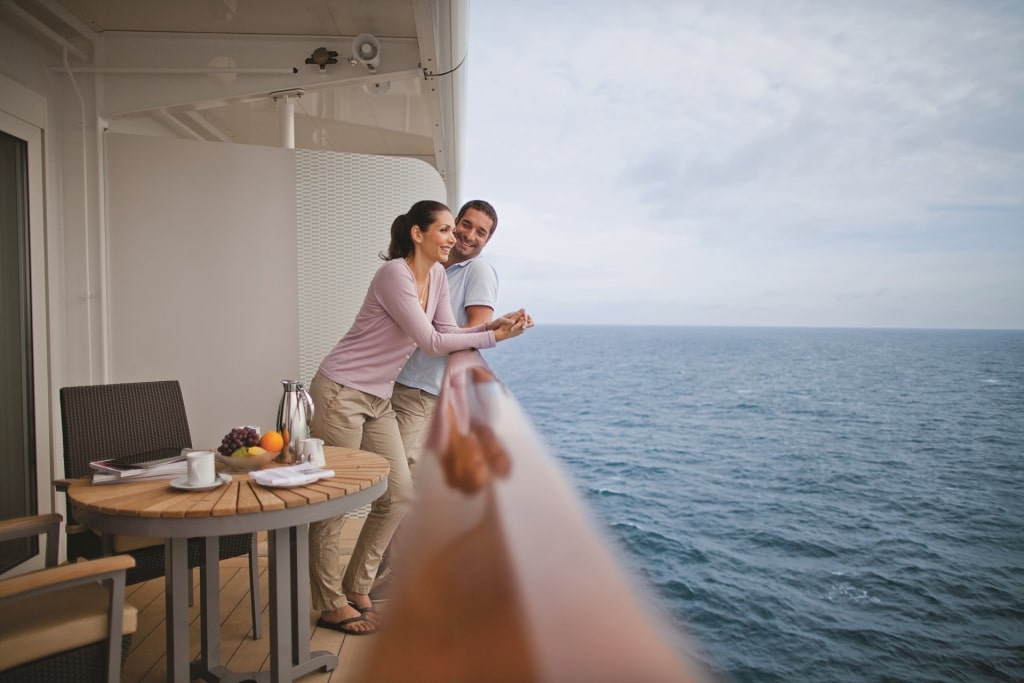
If you feel seasick at the start of a cruise, the good news is that for the great majority of passengers, seasickness usually subsides once you get your “sea legs,” which means your senses adjust and your equilibrium returns.
For most passengers who feel seasick at the start of a cruise, taking over-the-counter remedies and using the techniques recommended in this article will help you feel better in a few hours to a day or two. In some cases, particularly in rougher sea weather, seasickness may last longer.
Can you feel the ship move on a cruise?

Celebrity Cruises’ fleet of innovative cruise ships are so well designed and engineered that most of the time you won’t even feel the ship moving. Each ship is designed to give you as smooth a ride as possible without compromising the multiple activities available onboard and the spectacular on-deck views.
Our ships have stabilizers to keep the boat from rocking. Even a tilting of 1% is considered unacceptable, and Celebrity Cruises uses advanced technology to make sure your ship stays stable and calm.
What kind of cruise ships are best to avoid seasickness?
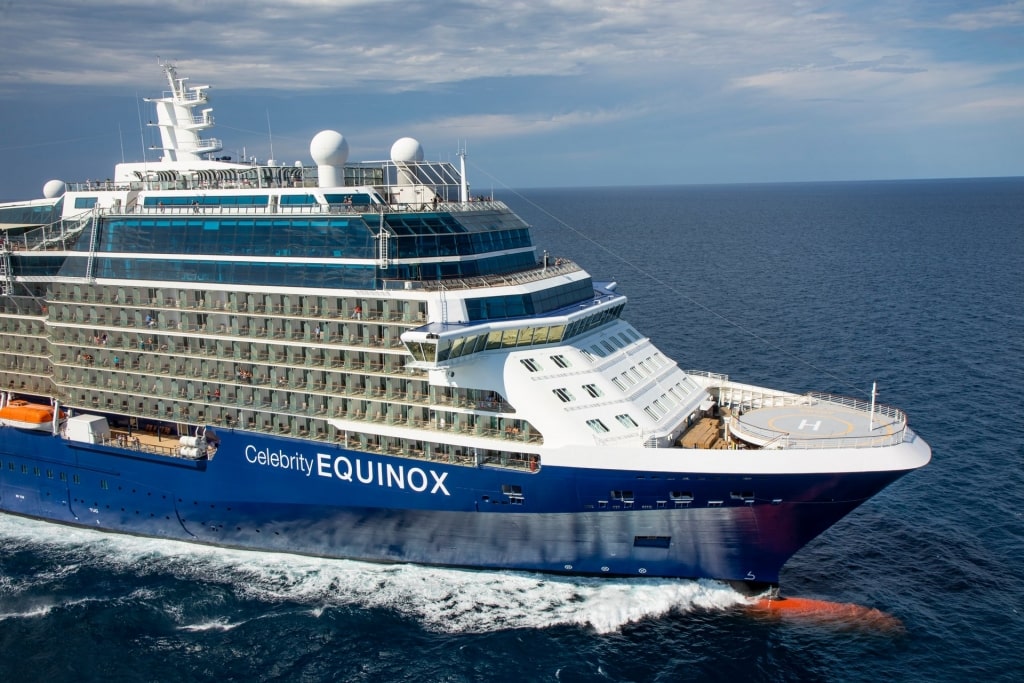
If you’re concerned about being seasick on a cruise, it’s good to know that Celebrity’s Solstice-class ships , which include Celebrity Solstice, Celebrity Silhouette, Celebrity Equinox, Celebrity Eclipse, and Celebrity Reflection, are built for smooth sailing, with fin-like stabilizers mounted beneath the ship’s waterline to ensure smooth sailing.
To give you an idea of the size and heft of these ships, each is built in post-Panamax dimensions, meaning they are too large to sail through the locks of the Panama Canal. At 122,000 to 126,000 tonnes, they glide through the water at a comfortable average speed of 24 knots, or about 27 miles per hour. They are steel-hull constructed and built with the safety and comfort of passengers in mind.
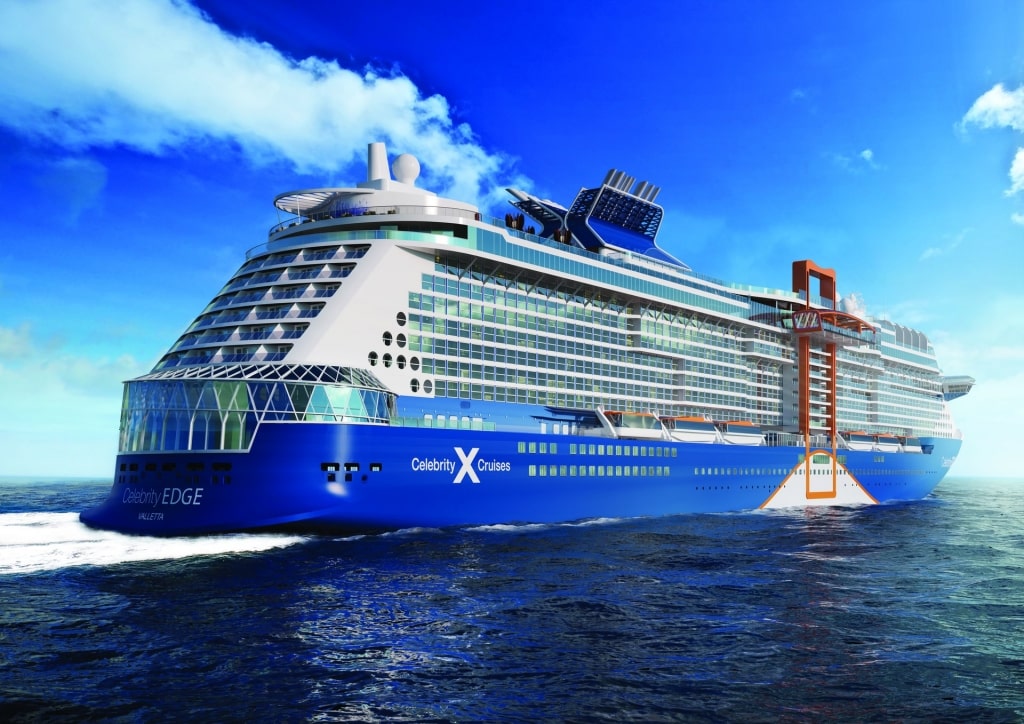
Celebrity’s newest class of ships, the Edge class, which includes Celebrity Edge and sister ship, Celebrity Apex , are the largest ships in our fleet. At 129,500 tonnes and reaching average cruising speeds of 22 knots, or about 25 miles per hour, they, too, are steel-hull constructed with stabilizers to ensure the safety and comfort of the passengers they carry.
Where is the best place to sail to avoid getting seasick on a cruise?

If you know you’re especially susceptible to seasickness, avoid itineraries that spend a lot of time sailing in open water. Cruise itineraries that stay within a sea, such as European cruises that sail along the Mediterranean Sea or Caribbean cruises that depart from San Juan, Puerto Rico are often good bets for having relatively calm waters during cruises.
One way to test the waters if you’re concerned about getting seasick on a cruise is to book a short cruise on a large ship that sails in calm water. We offer 2-night cruises from Florida to the Bahamas on our Millennium-class ship, Celebrity Infinity, and our newly revolutionized Solstice-class ship, Celebrity Equinox.

You’ll have one day at sea in each direction in the usually calm waters between Fort Lauderdale or Miami and the Bahamas. When in port, you’ll have a day to relax and play in the warm sunshine, clear blue water, and white-sand beaches of Nassau .
Another way to minimize your chances of becoming seasick on a cruise is to book a cruise that sails on one of our largest ships, like Celebrity Edge or Celebrity Apex, with 10- or 11-night itineraries that sail within the generally calm waters of the Mediterranean Sea.

Cruise from Rome on a 10-night itinerary visiting some of the most beautiful destinations in the Mediterranean, like Sicily, Naples, and the gorgeous Greek Islands. Or, sail an 11-night itinerary departing from Rome to Naples and Messina, Corfu, Greece, and up the Dalmatian Coast to Dubrovnik and Split, Croatia, and Trieste in Northern Italy.
On each of these sailings, you’ll only have two nights at sea, with the remaining time spent in port enjoying the glorious sights and pleasure of the Mediterranean.
When choosing an itinerary to avoid seasickness, consider the time of year as well. For instance, the best time to cruise the Caribbean is outside the hurricane season—the months of June through November—as they can increase the wave height and the ship movement you might feel while at sea.
Read: Cruising During Hurricane Season
What’s the best stateroom location to avoid motion sickness on a cruise?
To reduce motion sickness, choose a stateroom in the middle of the ship on a lower deck. You will feel any sway of the ship less in this section.
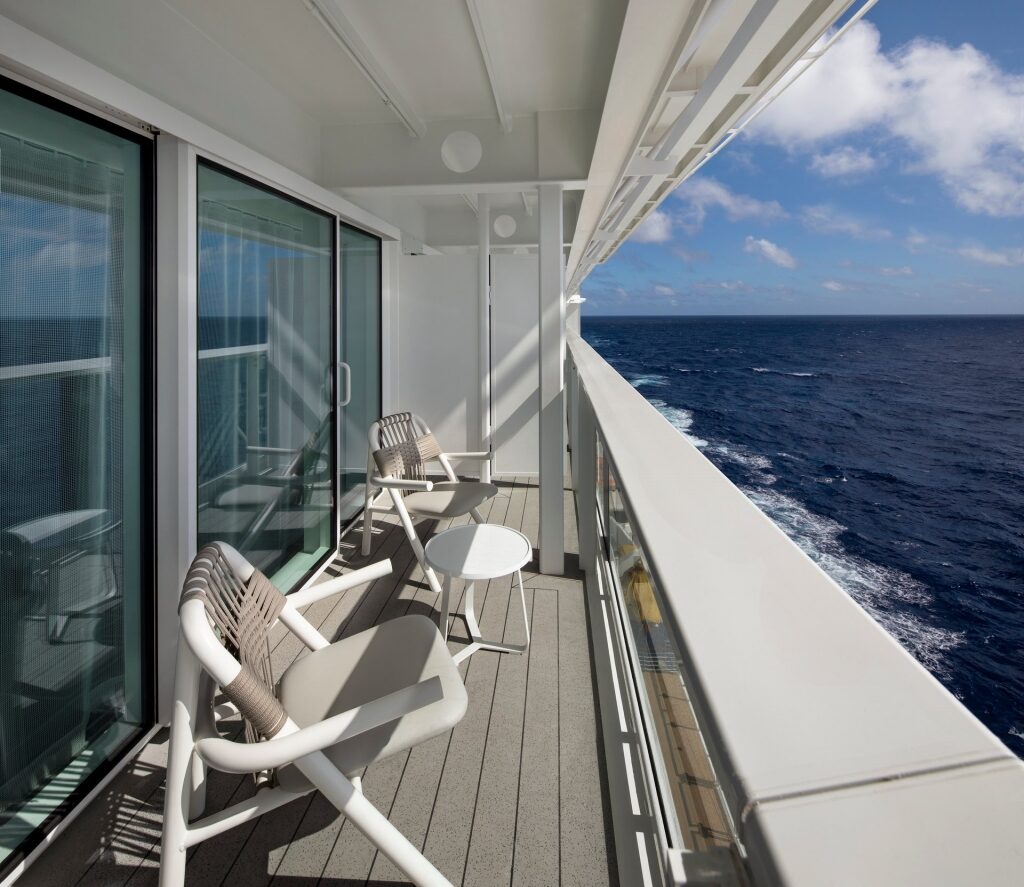
Although it may seem counterintuitive, if you’re worried about seasickness on a cruise, book a stateroom with a window or a veranda. Fresh air access and a horizon view will help alleviate seasickness symptoms.
If lower levels are already booked or you’d like to be on a higher deck for an elevated view or to be closer to the activities on the top decks, book a stateroom in the middle of the ship and avoid staterooms near the front or back (bow or aft) of the ship.
The ships’ deck plans will help you pinpoint the best stateroom location for your needs.
Read: Cruising While Pregnant
What remedies are available to alleviate seasickness on a cruise?
One way to avoid seasickness on a cruise is to get enough rest. Lack of sleep and exhaustion can make you more susceptible to motion sickness.
Motion sickness medication and natural remedies

If you think you might experience motion sickness on a cruise, it’s best to be prepared. There are several over-the-counter, natural, and doctor-prescribed remedies that can help. Be sure to pack whatever seasickness remedy you choose in your carry-on bag, and take as directed, which may mean a few hours prior to boarding your ship.
If you have a doctor-prescribed transdermal patch (scopolamine), apply it as directed at least four hours before boarding your ship. The patch is active for three days, so if you’re traveling on a longer cruise, you should pack replacements.
Don’t panic if you forget to pack motion sickness medication. At the guest relations desk onboard, you’ll find tablets that will help combat seasickness.

There are also some tried and true natural remedies to alleviate the symptoms of seasickness. Ginger, whether in pill form or as a candy, is easy to keep handy as you cruise. Sucking on peppermint candy or smelling peppermint oil is also helpful.
Acupressure & acupuncture
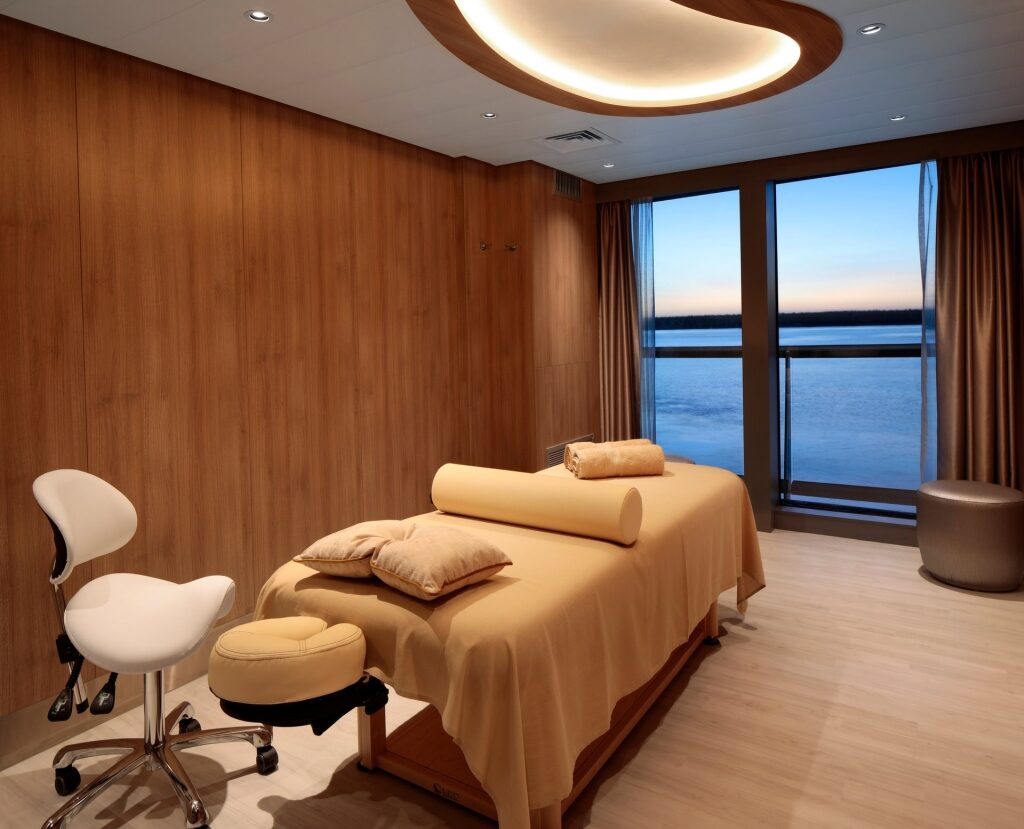
Wearing an acupressure band around your wrist is another natural way to alleviate sea sickness. If you want to take pressure-point therapy one step further, forego the band and seek out an acupuncture specialist. Our onboard spas have acupuncture technicians who will help you relieve your motion sickness.
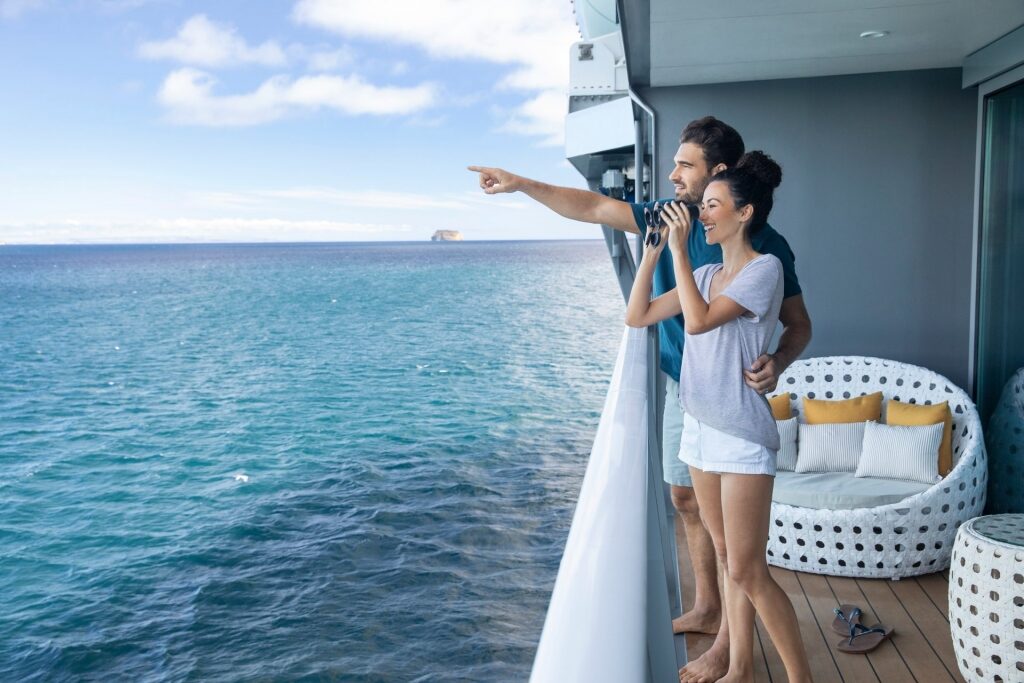
Though being seasick on a cruise may make you want to curl up in your stateroom and stay there, you’ll be amazed at how dramatically better you’ll feel if you get out and breathe in some fresh air. At the very least, step out on your veranda, take a breath of fresh air, find a spot on the horizon, and keep your eyes on it.
Make an effort to get up to the top deck and do the same. Breathing in fresh air while keeping your eyes on the horizon helps your mind and body get back in sync and may alleviate your symptoms.
What should I eat and drink to avoid motion sickness on a cruise ship?
It may sound like the last thing you want to do, but keeping your stomach full by eating small meals and snacks throughout the day can help ward off nausea from seasickness. At the very least, regularly sipping ginger ale and eating crackers may do the trick for the first 24 hours.
If you’re prone to seasickness, be cautious of your alcohol intake as alcohol can increase dehydration and exacerbate the effects of motion sickness.
Staying hydrated during your cruise is vital, as dehydration can make you feel more seasick. Our Zero Proof drink package includes unlimited bottles of sparkling and still water, such as San Pellegrino, Acqua Panna, and Evian.
Now that you know how to combat seasickness, browse our cruise itineraries , view cruise accommodations, fights, and activities all in one place or speak to one of our cruise vacation specialists at 1-800-852-8086.
Related Itineraries
Key West & Bahamas
- 4 nights ON CELEBRITY SILHOUETTE
- DEPARTING FROM FORT LAUDERDALE, FLORIDA
- Starting from $514 USD
Western Caribbean & Perfect Day
- 5 nights ON CELEBRITY REFLECTION
- Starting from $599 USD
Nassau & Bimini
- 5 nights ON CELEBRITY SUMMIT
- DEPARTING FROM MIAMI, FLORIDA
- Starting from $669 USD
Key West, Belize and Grand Cayman
- 7 nights ON CELEBRITY APEX
- Starting from $1004 USD
- 3 nights ON CELEBRITY REFLECTION
- Starting from $1087 USD
Ultimate Southern Caribbean
- 10 nights ON CELEBRITY BEYOND
- Starting from $1638 USD

Related Articles
8 Tips for Buying Souvenirs in Port
The Only Cruise Packing List You’ll Ever Need
12 Wildlife Photography Tips for Beginners
What to Wear on a Cruise: The Ultimate Guide
14 Essential Cruise Packing Tips
17 Cruise Tips for First-Timers
Find Out if You Need a Passport to Go on a Cruise
Why Cruises Are the Best Family Vacation
13 Sustainable Shore Excursions to Add to Your Bucket List
Exciting Cruise Nightlife Options on Celebrity
Bucket List Cruises for Seniors Over 60
How to Choose the Best Stateroom on a Cruise
Free Vacation Planning Services

CALL US 888-751-7804
Sign Up for Special Offers
- First Name *
- Last Name *
- Email Address *
- Country * Country Afghanistan Albania Algeria American Samoa Andorra Angola Antigua and Barbuda Argentina Armenia Australia Austria Azerbaijan Bahamas Bahrain Bangladesh Barbados Belarus Belgium Belize Benin Bermuda Bhutan Bolivia Bosnia and Herzegovina Botswana Brazil Brunei Bulgaria Burkina Faso Burundi Cambodia Cameroon Canada Cape Verde Cayman Islands Central African Republic Chad Chile China Colombia Comoros Congo, Democratic Republic of the Congo, Republic of the Costa Rica Côte d'Ivoire Croatia Cuba Curaçao Cyprus Czech Republic Denmark Djibouti Dominica Dominican Republic East Timor Ecuador Egypt El Salvador Equatorial Guinea Eritrea Estonia Ethiopia Faroe Islands Fiji Finland France French Polynesia Gabon Gambia Georgia Germany Ghana Greece Greenland Grenada Guam Guatemala Guinea Guinea-Bissau Guyana Haiti Honduras Hong Kong Hungary Iceland India Indonesia Iran Iraq Ireland Israel Italy Jamaica Japan Jordan Kazakhstan Kenya Kiribati North Korea South Korea Kosovo Kuwait Kyrgyzstan Laos Latvia Lebanon Lesotho Liberia Libya Liechtenstein Lithuania Luxembourg Macedonia Madagascar Malawi Malaysia Maldives Mali Malta Marshall Islands Mauritania Mauritius Mexico Micronesia Moldova Monaco Mongolia Montenegro Morocco Mozambique Myanmar Namibia Nauru Nepal Netherlands New Zealand Nicaragua Niger Nigeria Northern Mariana Islands Norway Oman Pakistan Palau Palestine, State of Panama Papua New Guinea Paraguay Peru Philippines Poland Portugal Puerto Rico Qatar Romania Russia Rwanda Saint Kitts and Nevis Saint Lucia Saint Vincent and the Grenadines Samoa San Marino Sao Tome and Principe Saudi Arabia Senegal Serbia Seychelles Sierra Leone Singapore Sint Maarten Slovakia Slovenia Solomon Islands Somalia South Africa Spain Sri Lanka Sudan Sudan, South Suriname Swaziland Sweden Switzerland Syria Taiwan Tajikistan Tanzania Thailand Togo Tonga Trinidad and Tobago Tunisia Turkey Turkmenistan Tuvalu Uganda Ukraine United Arab Emirates United Kingdom United States Uruguay Uzbekistan Vanuatu Vatican City Venezuela Vietnam Virgin Islands, British Virgin Islands, U.S. Yemen Zambia Zimbabwe

STAY IN THE KNOW
Thank you for subscribing.
See you on board soon.

Motion sickness can put a damper on your cruise experience , but fortunately, there are several effective medications available to help alleviate its symptoms. When it comes to choosing the best motion sickness medicine for cruises, a few options stand out. These include medications, seasickness patches, Sea-Bands, and even specific cabin choices that can help alleviate motion sickness.
It's important to remember that each individual's response to medication or treatment varies. What works best for one person may not be suitable for another. So, when seeking the most effective prevention method, consider your unique needs and reactions. Some cruisers find relief with motion sickness patches, while others prefer home remedies like herbal teas.

Seasickness, while not life-threatening, can put a damper on your cruise enjoyment due to symptoms such as nausea, stomach discomfort, and vomiting. It is believed to result from the visual disorientation caused by being on a moving object (such as a ship), conflicting with our body's natural sense of balance. Regardless of the exact cause, many cruisers are familiar with the unpleasant feeling that rough, rocking seas can bring.
However, seasickness isn't solely triggered by choppy waters. Scientific studies have shown that some individuals experience seasickness due to psychological suggestions – essentially convincing themselves that being on a ship will make them unwell. Conversely, those who can put such concerns out of their minds often have smoother sailing.
Certain people are naturally more prone to motion sickness and may experience it more intensely during rough seas. Medical experts note that seasickness is more common in children and women, while interestingly, children under the age of two appear to be immune. Additionally, older individuals are generally less susceptible.
If you have a history of motion sickness or are concerned about potential symptoms, it's advisable to take preventive measures in advance to enhance your cruise experience.
Drug-Free Options
If you prefer to avoid medications, there are alternative solutions and discussions regarding seasickness remedies. Many passengers find relief by wearing a Sea-Band wristband upon embarkation. This user-friendly, acupressure-inspired device features a plastic bead that applies pressure to the Nei-Kuan pressure point on the inner wrist. It effectively reduces nausea and vomiting without causing any side effects. Sea-Bands are available in sizes for both adults and children and can even be used by pregnant women. You can purchase Sea-Bands without a prescription at major drug stores.
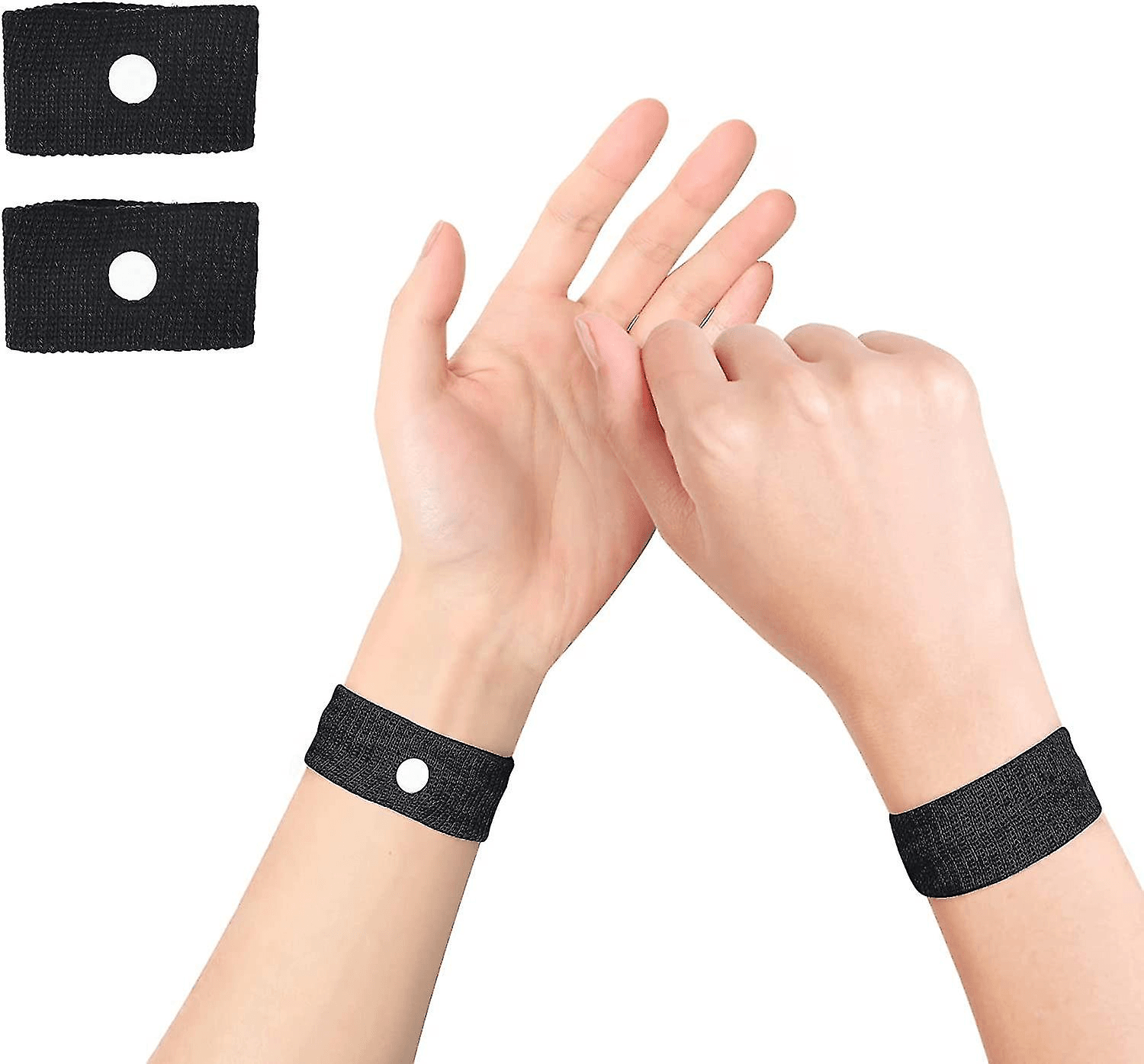
Additionally, some individuals advocate the use of ginger, which studies have shown to alleviate motion sickness-related nausea. Ginger is available in various forms, including powder, tea, pills, and candy. Another remedy involves consuming green apples, which some find helpful for nausea. On certain ships, you may even find green apples and crackers listed on their room service menus.
Drug Remedies
When it comes to remedies for seasickness, one widely recommended option is the Transderm Scop patch. You apply this scopolamine patch behind your ear at least eight hours before potential exposure, and it remains effective for up to three days. Keep in mind that you'll need a prescription for this preventive measure. While it can be effective, it may also lead to side effects like dry mouth, blurred vision, drowsiness, and dizziness.
For over-the-counter solutions to prevent or treat seasickness, you can consider medications such as Dramamine, Meclizine (commonly known as Bonine), or diphenhydramine (commonly referred to as Benadryl). Some cruise ships provide these medications freely, and you can also find them in the ship's sundries shop. It's important to note that the most common side effect of Bonine and Benadryl is drowsiness, and alcohol can intensify this effect.

For stronger and more effective prescription medications, you'll need to consult a physician. While the ship's doctor can provide them, this often involves the cost of an office visit in addition to the medication expense. Prescription options include Promethazine and ephedrine, which, when taken together, can offer rapid relief but may also lead to side effects like drowsiness. Another alternative is suppositories, administered by the ship's physician, which can be highly effective for some individuals.
More Tips & Tricks
To adapt to life on a cruise ship, consider spending ample time on the open deck, using the horizon as a reference point to maintain your balance.
Another option is booking an outside cabin located in the ship's middle, which is the natural balance point. Having a window will also provide a consistent view of the horizon.
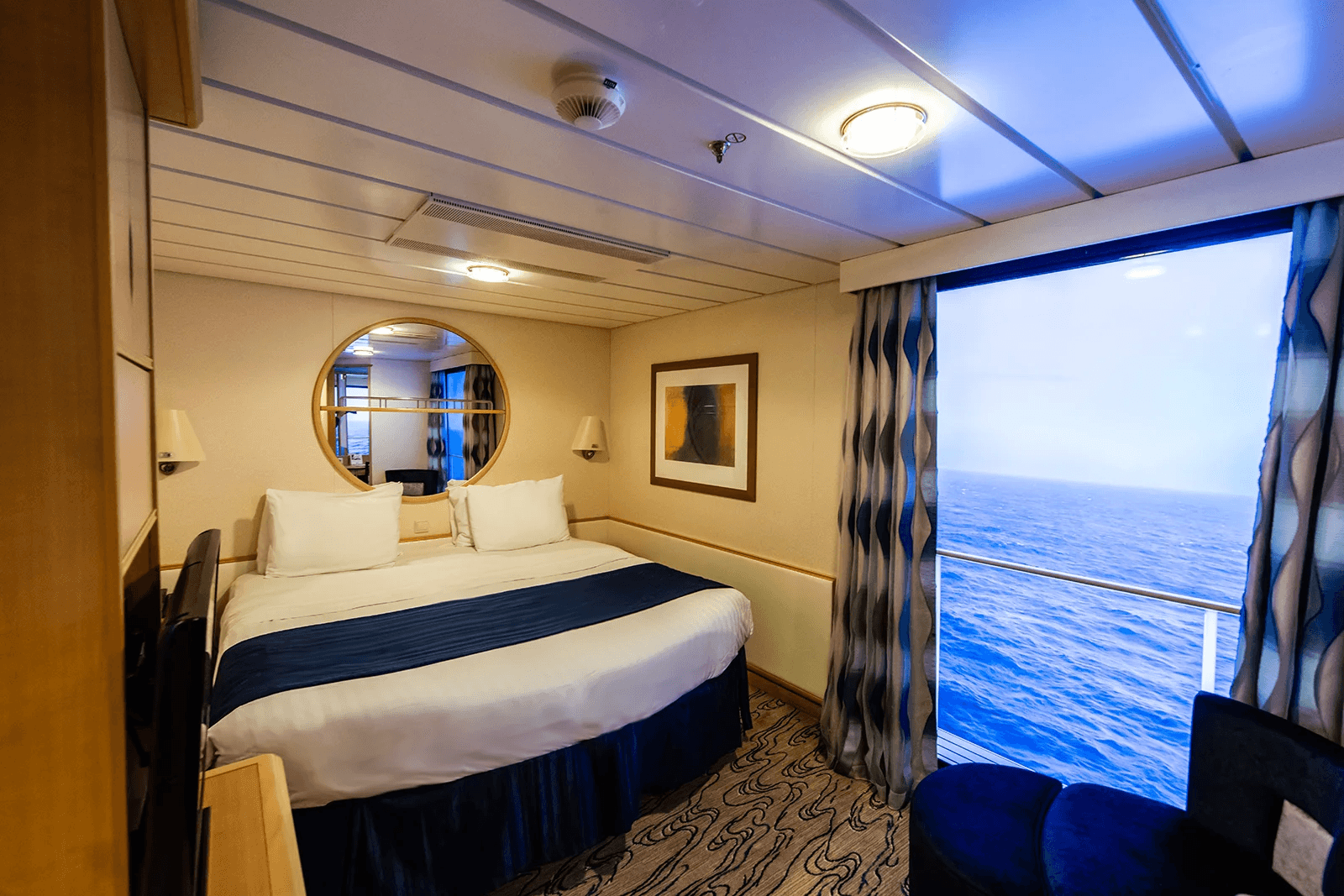
Choosing port-intensive cruises with fewer days at sea is a good strategy to minimize the time spent in rough waters. It's best to avoid itineraries known for rough conditions, such as the Bass Strait between Australia's mainland and Tasmania or the Tasman Sea between Australia and New Zealand. North Atlantic crossings and the Caribbean during hurricane season (June through November) should also be approached with caution.
Opting for larger, modern ships is a wise choice. Most of today's cruise ships, with sizes exceeding 100,000 tons, are equipped with stabilizers that help ensure a smoother voyage.
Keep in mind that individuals respond differently to various remedies. It's up to you to conduct some research and experimentation to find what works best.
If you or a family member are susceptible to seasickness, it's important to be well-prepared. Ensure you have all the necessary items in your medical kit, as there's no certainty that specific items or over-the-counter medications will be accessible on the ship. In case of severe motion sickness symptoms, reach out to the ship's medical team to explore safe remedies
Finding the best motion sickness medicine for your cruise is essential to ensure a smooth and enjoyable voyage. Whether you opt for prescription medications or over-the-counter remedies, it's crucial to prioritize your comfort and well-being while at sea. And while you're making preparations for your next cruise adventure, don't forget to turn to Cruisebound , your trusted online platform for booking cruises and discovering the best cruise deals.

- Cruise Advice
Seasickness on a Cruise: 7 Tips to Avoid It

Doug Parker
- June 23, 2023
Those that struggle with motion or seasickness don’t have to stop going on cruises! With our 7 helpful tips you’ll get to enjoy a weekend out at sea all you want.

Before we get into it, let’s start by defining the term motion sickness – just what causes it?
Seasickness happens when your brain gets conflicting messages from your inner ears, eyes, and sensory nerves. Your inner ears help with balance by detecting motion while your eyes don’t see that movement. It’s that inconsistency that confuses and agitates your brain.
And while some people are more prone to seasickness than others, it’s still something that could ruin your boat trip. So, check out how you can stop that from happening.
1. Choose the Right Cabin
Picking the right cabin to stay at goes a long way in balancing out your seasickness. We’ve found that the best cabins to book from are those present on the middle or lower deck.
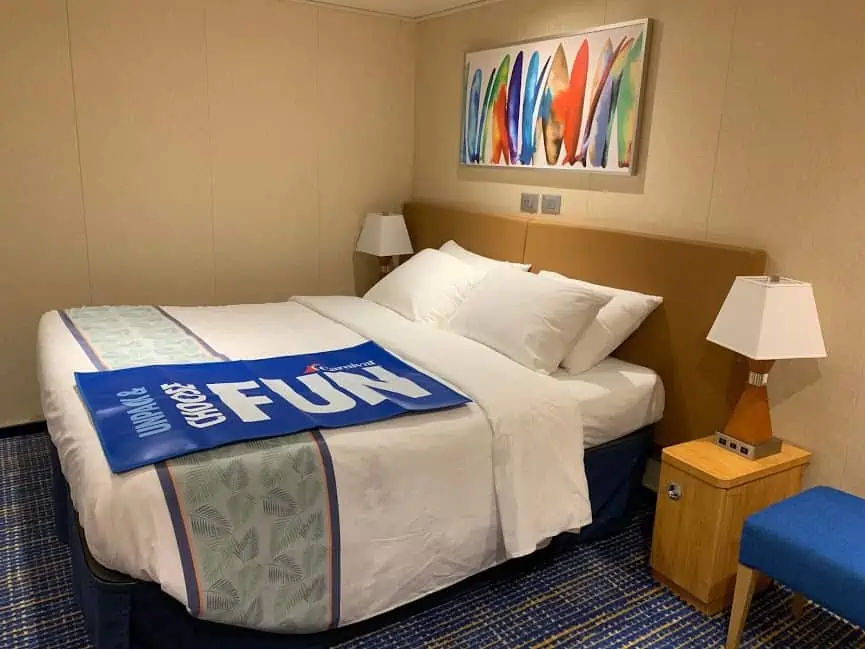
Mid-Ship Cabins
Book a mid-ship cabin to experience the least amount of motion on board. Cabins near the front or back of the ship are more prone to movement, making it harder for travellers prone to seasickness.
So, to avoid this, consider the mid-ship cabins, which provide a smoother ride since they are in the centre of gravity on board. You may also upgrade to a balcony room. Those provide both fresh air and natural light that can help reduce nausea while giving stunning sea views.
Lower Decks
Choosing a room on the lower decks can significantly reduce the rocking sensation and help prevent seasickness. If your motion sickness is particularly horrible, pick a cabin in the middle of the lower deck. Such cabins experience the least movement and are as stable as it gets.
Read more: Motion Sickness: Picking the right cabin, itinerary, and cruise ship
2. Take Motion Sickness Medication
When it comes to meds, you have the choice to pick from the following:
- OTC medication
- Prescription meds
- Acupressure wrist brands
Below, we cover each point in further detail to help you figure out the best course of action for your seasickness.
Over-the-Counter Medication
Ginger supplements are a popular natural remedy for motion sickness. They can be capsules or chewable tablets, which you can buy in most drugstores and health food stores. Ginger helps alleviate nausea and vomiting, making it a practical option for those prone to seasickness.

Consider antihistamines, such as Dramamine and Bonine, as well. They block messages between the inner ear and brain that cause nausea and vomiting.
They’re even considered among the best motion sickness medicine for cruises. However, they may cause drowsiness or other side effects .
So, it’s important to follow the recommended dosage instructions carefully – taking more than what’s prescribed won’t increase effectiveness and can only lead to unwanted side effects.
Bonine vs Dramamine
The formula composition of both Bonine and Dramamine is the main difference between either drug. While the two are effective in reducing your motion sickness, Dramamine can make you more drowsy than Bonine.
That’s because Dramamine contains dimenhydrinate – which while works more quickly, will cause more drowsiness. On the other hand, Bonine contains meclizine, which provides long-lasting effects and is associated with less drowsiness.
Additionally, meclizine stays in your body for up to 24 hours so you can enjoy the cruise to its fullest. Dimenhydrinate lasts in the body for no more than 4 to 6 hours, though.
When to Take Dramamine Before Cruise?
If you insist on taking Dramamine, know that the medication takes at least 30 minutes to 1 hour to kick in.
As such, it’s recommended that you take it an hour or so before boarding the ship or taking on an activity that triggers your motion sickness. Once you feel your symptoms alleviating, you can proceed to take Dramamine as directed on the packaging.
And if you were to take Dramamine after your motion sickness has taken effect, it’ll still take 30 minutes to an hour before you feel any relief.
Prescription Medication
If over-the-counter medication isn’t working for your motion sickness, then prescription medication may be the answer.

Scopolamine patches , for instance, worn behind the ear, can help prevent nausea and vomiting caused by motion sicknesses. Discuss all options with your doctor before deciding on prescription medication for seasickness relief during your cruise vacation.
Keep in mind also that seasickness medication can be pricey depending on what brand and type you go with. So before travelling, check discount vouchers at Boots and get the best travel sickness medicines.
Use Acupressure Bands
Acupressure bands are a great way to combat seasickness on a cruise ship. These bands use pressure points on the wrist to alleviate nausea and dizziness caused by motion sickness.
They stimulate the body’s natural healing processes, making them a practical, drug-free solution for seasick people.
While there is limited scientific evidence of their effectiveness, many people find them helpful as a non-invasive alternative to medication.
Look for acupressure bands at drugstores or online retailers. They fit comfortably around your wrist and have adjustable pressure settings. It’s essential to wear them before you begin feeling symptoms of seasickness though, so be sure to put them on before setting sail.
Where to Buy Acupressure Bands?
You can buy acupressure bands at Amazon or Walmart, which offer competitive pricing options, and at pharmacies, such as CVS or Walgreens. Specialty stores like REI or outdoor supply shops may also sell acupressure bands.
It’s important to note that not all acupressure bands are the same, so do your research before purchasing. Double-check reviews and ratings from customers who have used the product before.
4. Stay Hydrated
Drinking plenty of water throughout the day can help prevent dehydration, which can worsen motion sickness symptoms.
So, be sure to carry a refillable water bottle and take frequent sips—especially if you’re spending too much time in the sun or participating in activities that make you sweat.

Additionally, limit your intake of alcoholic beverages to avoid seasickness on a cruise. Alcohol can dehydrate you and amplify the effects of motion sickness, making it more likely for you to feel unwell.
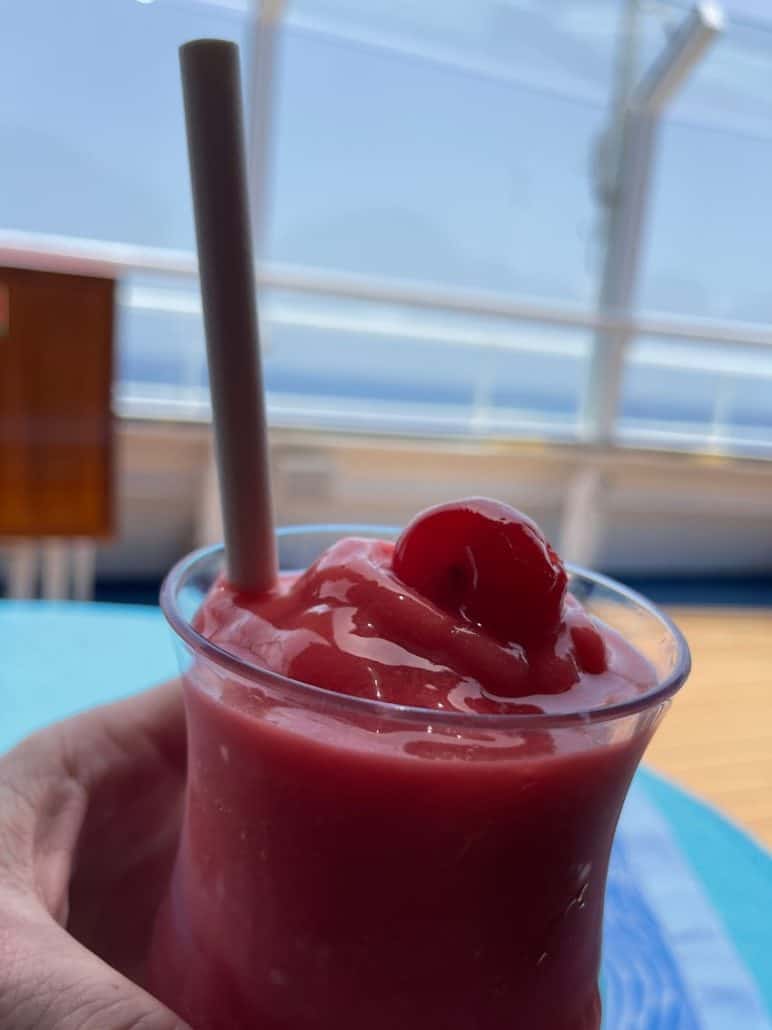
Avoid energy drinks that contain high levels of caffeine as well. These glasses can raise heart rate and blood pressure, triggering symptoms such as nausea, dizziness, etc., making it difficult to enjoy your time at sea.
Opting for plain water with electrolytes added – like coconut water – will keep your hydration balanced without causing unwanted side effects.
5. Eat the Right Food
Eating the right foods is one of the best ways to avoid seasickness on a cruise ship .
Stay clear of heavy, greasy meals that can upset your stomach and make you more susceptible to motion sickness. Instead, stick to lighter fare, like fruits, vegetables, and lean proteins.
Don’t stop there; keep eating small meals throughout the day. Doing so will help keep your blood sugar levels stable and prevent feelings of nausea or dizziness.
Consider snacking on crackers or hard ginger candy for extra stomach-soothing goodness between larger meals.
6. Get Regular Fresh Air
Take a break and head up to the deck for some fresh air. Breathing in the salty sea breeze can help alleviate seasickness symptoms and provide a calming effect.

If it’s too windy, try finding a sheltered spot where you can feel the breeze without being exposed to strong gusts.
7. Consider Natural Seasickness Remedies
Remember that old saying about an apple a day can keep the doctor away? While that might not be true, eating apples can alleviate seasickness—but not just any apple, though.
Look for green Granny Smith apples; their pectin combined with natural sugars reduces acid and settles topsy-turvy stomachs.

Peppermint is also known to have the same effects against seasickness. If you’re lucky, you might find some cruise line sundry shops selling peppermint oil.
At the end of the day, cruisers have little to lose by trying out some of these natural solutions for seasickness before taking medication. Their low cost and ease of access are appealing.
Final Thoughts
Don’t let motion sickness keep you from experiencing what the cruise ships offer!
Just remember to stay hydrated, avoid heavy meals, and take preventative medication if necessary to avoid seasickness on a cruise.
The U.S. Centers for Disease Control also lists more tips and remedies to help avoid motion and seasickness .
Medical Disclaimer: This article is not a substitute for professional medical advice, diagnosis, or treatment. Always seek the advice of your physician or other qualified health providers with any questions you may have regarding a medical condition.
Pin it for later!

Recent Posts
Cruise lines and port clash over using millions in passenger fees, 35.7 million passengers expected to cruise in 2024, unfazed by higher prices, new cruise ship attraction will dangle passengers 160 feet over ocean, four new mega ships on order for norwegian cruise line, share this post, related posts.

Hannah Waddingham Tapped for Godmother of Princess Cruises’ Sun Princess

Easier Access to Princess Cruises in Florida with Improved Train Service

Bringing you 15 years of cruise industry experience. Cruise Radio prioritizes well-balanced cruise news coverage and accurate reporting, paired with ship reviews and tips.
Quick links
Cruise Radio, LLC © Copyright 2009-2024 | Website Designed By Insider Perks, Inc
- Twitter / X
- Readers' Choice
- Food & Drink
- Arts & Culture
- Travel Guides
USA TODAY 10Best
Avoid getting motion sickness on a cruise: 10 tips and tricks to keep you steady

February 15, 2024 // By Tamara Gane
By Tamara Gane February 15, 2024

If you’re preparing for a cruise, you may wonder how to avoid motion sickness. After all, nothing spoils the magic of seeing a whale breach or a sunset at sea like nausea or dizziness. Even the most experienced cruisers could fall prey to seasickness on a cruise ship , but this doesn't mean you should change your vacation plans. It simply means you should be prepared so nothing comes between you and a fantastic cruise.
To help, we asked Dr. Amber Robins , a family and lifestyle medicine doctor, about the most effective ways to prevent getting seasick on a cruise. She provided simple, yet vital answers to help you feel your best during your next sailing.
What is the best medicine for motion sickness?
“Many people benefit from wearing scopolamine patches that help treat nausea and motion sickness,” Robins states. These patches work with the central nervous system to calm delicate areas like the stomach and bowels. This helps prevent motion sickness instead of merely treating symptoms after they occur.
Advertisement Advertisement
Since scopolamine is available by prescription, consult your doctor before your cruise to see if the patches are for you.
Over-the-counter medicines to prevent seasickness

“Over-the-counter medicines like Dramamine can help improve the nausea that comes with seasickness,” according to Robins. She explains that Dramamine blocks the histamine receptors, which leads to a balanced feeling. Note, however, that since Dramamine is an antihistamine, it may cause drowsiness in some users.
Bonine is another over-the-counter option; its main ingredient is meclizine, which, for many people, treats symptoms without causing drowsiness. The directions on the packaging indicate that Bonine, which acts as a preventative, should be taken an hour before traveling and then once a day, like a daily vitamin, for the length of the cruise trip.
Herbal cures for motion sickness
If you're searching for natural remedies for motion sickness, Robins says ginger may help. Ginger has historically been used to treat nausea. The natural herb is especially popular with pregnant women suffering from morning sickness. If feeling nauseous at sea, try fighting that queasiness with ginger, which is widely available in the form of capsules or chews .
Do acupuncture bracelets and wristbands help avoid seasickness?
If you’re wondering about the effectiveness of acupuncture bracelets and wristbands for preventing seasickness, Robins says studies are mixed.
“The bracelets are made to push on a specific area of the wrist. For some, this has decreased nausea and vomiting," she says. “It's hard to conclude that this bracelet would work for everyone.”
Does staring at the horizon help with motion sickness?
Carnival Cruise Line recommends staring at the horizon to prevent motion sickness, and scientific evidence supports that advice.
Life at sea can be disorienting. The disconnect between the movement of the ship and the movement of your body can affect your sense of equilibrium. Fixing your gaze on the horizon provides a reference point so you can reclaim your sense of balance.
If reading makes you feel seasick, put the book away

If reading in a vehicle makes you feel carsick, you're experiencing disorientation and motion sickness . Unfortunately, those symptoms can also happen on a cruise. If you start to feel nauseous, dizzy, or unwell while staring at a book or screen at sea, put the reading material aside for a while and see if the symptoms improve.
Can shore excursions help fight motion sickness?
Robins says that disembarking from the ship may alleviate the symptoms of seasickness. While this advice may not be practical at sea, it is once you pull into port. Getting back on land can help reclaim your sense of balance. Plus, now you have a great excuse to book some incredible shore excursions when you schedule your cruise itinerary .
How to pick the right cabin to prevent seasickness

Choosing the right cabin is important when booking a cruise. According to Carnival Cruise Line, ships rock and sway the most at the edges. If you book a cabin near the middle, you’re less likely to be affected by all that movement. In addition, cabins with windows or balconies make it easier to focus on the horizon if you feel woozy.
Can dehydration cause motion sickness?
“Staying hydrated can help improve symptoms like dizziness, nausea, and vomiting that can come with seasickness,” states Robins. So be sure to drink plenty of water. Since alcohol can lead to dehydration, avoid drinking in excess.
Can the ship doctor help if you’re feeling seasick?
Cruising is truly a bucket-list experience. Don’t let motion sickness spoil your trip. If you can’t find relief from your seasickness, speak to the ship doctor and ask for help alleviating your symptoms. Most cruise lines have motion sickness medicines and other remedies available to passengers at no charge.

About Tamara Gane
Tamara Gane is an expert panel member for 10Best Readers' Choice Awards. She's based in Reno/Lake Tahoe and in addition to USA Today 10Best, her work has been published in Travel & Leisure, Fodor's Travel, The Washington Post, SF Gate, Houston Chronicle, Lonely Planet, and more.
Read more about Tamara Gane here.
Connect with Tamara via: Instagram
How To Plan For A Cruise If You Suffer From Motion Sickness

Motion sickness, or seasickness, is one of the more unfortunate realities of cruising for many passengers. The intense feelings of nausea and cold sweats can affect anyone, though Cleveland Clinic explains that women and children under 12 are the most likely to be affected. Those with a family history of motion sickness, or those taking hormonal birth control, are also more likely to experience motion sickness, along with those who are pregnant and people with inner ear disorders.
The brain interprets motion through the nervous system, which comprises of the inner ear, eyes, and the body surface, per Medical News Today . People experience motion sickness when there's a discrepancy between the sensations of these different pathways — or, put simply, when there's a difference between what a person sees and what they feel. For example, if you are in your stateroom on a cruise ship, your view will likely be of a room that's not moving. However, your inner ear will pick up on the rocking movement of the ocean. This conflict causes you to feel sick.
Feeling seasick can be an awful experience, but the good news is there are several ways to alleviate the uncomfortable symptoms so you can enjoy your cruise. Many of them are similar to the methods used to get rid of car sickness .
Booking a cruise when you get motion sickness
If you're prone to motion sickness, prevention should start well before you board the cruise. Try to book a stateroom that is as close to sea level as possible and in the middle of the ship, per Celebrity Cruises . This is the part of the ship that is the least affected by the movement of the ocean. It's also important to book a room that has access to fresh air, either through a window or balcony, as this can reduce the symptoms of motion sickness. Keep in mind that ships traveling in open water are more likely to experience rough movement than those that stay close to the shoreline. So, if you experience severe motion sickness, it might be worth avoiding cruises that travel long distances across open water.
Knowing what to do ahead of time can also help you to respond in a helpful way when motion sickness hits. Don't panic if you start to feel sick. Rather, put down your phone or book and stare at the horizon. Dan Boater points out that reading anything, even on a screen, can worsen the symptoms of motion sickness. Snacking on dry crackers can alleviate sea sickness, so be sure to have some on hand. Also, packing anything with ginger or peppermint, such as candy or chews, can also help when motion sickness hits (via Navigate Content ). Peppermint and ginger essential oils are also a great oil combination for relieving nausea.
What to pack for motion sickness
When it comes to packing for a cruise when you experience motion sickness, there are a few other items that you should always have in your bag (and a few to leave out). Dehydration will worsen motion sickness symptoms, so pack a water bottle that you can refill and have with you at all times while on the ship, WebMD advises. By the same token, avoid packing or consuming anything with caffeine or alcohol, as these have a dehydrating effect.
According to Healthline , putting pressure on an acupressure point along your wrist called the nei-kuan can bring relief from motion sickness. Rather than trying to administer the pressure yourself, you can purchase anti-nausea bands to just slip on your wrists when you feel sick (via Prevention ). And of course, there are over-the-counter medications you can purchase ahead of your cruise that will provide relief. These come in the form of antihistamines and antiemetics which should be taken before you travel, per Health Direct . However, always talk to your healthcare provider before using medication, as many have side effects.
Seasickness is a bummer, but it doesn't have to stop you from cruising. Take a little care when choosing your cruise and stateroom, as well as when packing your bags, and you'll be able to manage the symptoms of motion sickness more effectively.

Everything you need to control seasickness
How to Prevent Motion Sickness on a Cruise
Motion sickness on a cruise won’t cause serious damage , but it will make your vacation absolutely miserable. There’s nothing worse than spending a whole cruise in bed after you’ve been planning and packing for weeks.
So let’s take a look at what motion sickness is and how to avoid it on your next cruise.
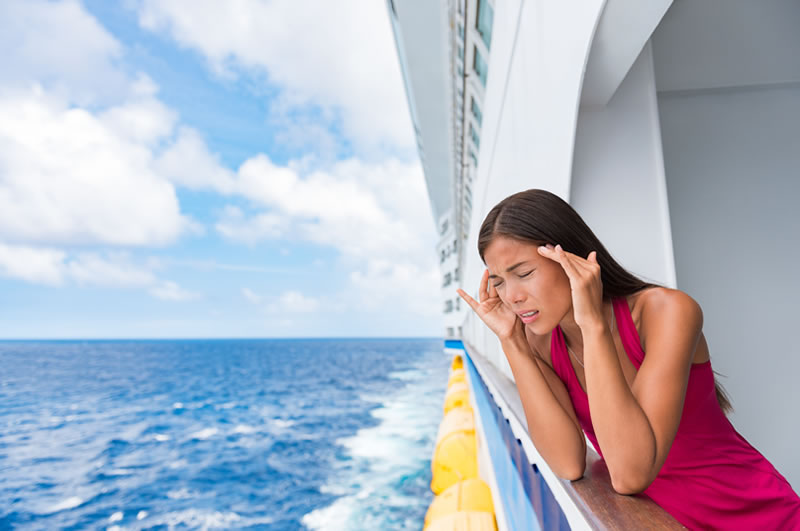
Why Do I Get Motion Sickness on a Cruise?
Your body has a balance-sensing system , which includes your inner ears, your eyes, and your sensory nerves. You start to feel motion sickness when one of these balance-sensing systems don’t match up with all the rest.
For example, if you’re in the cabin of a moving ship, your ears will feel the rocking of the waves but your eyes won’t see any movement. Because one sense says your body is moving and one sense says it’s not, the entire system gets confused .
This conflict causes motion sickness .
Who Gets Motion Sickness?
Anyone can get motion sickness , especially on a cruise. Depending on where your cruise is and what kind of boat you’re on, it’s important to remember every cruise will feel different.
So someone who has never experienced motion sickness on a cruise before might feel sick on a cruise they’ve never tried .
That said, motion sickness is most common in children between five and 12 years old, women, and elderly. It doesn’t seem to affect children under two years of age, so don’t worry about your toddler getting sick if you’re traveling with them.
Symptoms of Motion Sickness on a Cruise
There are several symptoms of motion sickness , which can all be wrapped up into a general sense of feeling ill.
These symptoms include :
If you notice one of these symptoms , even if it is minor, you should take measures to prevent it worsening right away. (We’ll get into how to do that later.)
Things You Shouldn’t Do if You Feel Motion Sick
If you ever get motion sickness on a cruise, there are several things you should stop doing to make sure it doesn’t get worse.
– Don’t stay below deck for an extended period of time, especially if you aren’t around any windows. Your inner ears will feel the rocking of the boat, but all your eyes will be able to see are solid walls.
– Your eyes know from experience those walls shouldn’t move, so being inside could make your sickness worse . Being on deck will allow you to see the horizon and the water moving around you.
– You should also stop any activities like reading or sewing. Again, looking at these items that your eyes think aren’t moving can bring on a new round of motion sickness.
The best way to deal with motion sickness is to prevent it before it happens. There are a lot of things you can do before you hop on a cruise that can spare your vacation headaches and upset stomachs.
1. Motion Sickness Medication
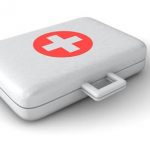
Bonine and Dramamine , both over the counter medications, can make a big difference. These medications can make you tired, so make sure you get the notion-drowsy kind.
Start taking them a day or two before your cruise for the best effect.
If you want to avoid medication , you can pick up a Sea-Band at most major drug stores. These cotton braces are worn around your wrist, and they have hard beads that press against the inside of your wrist.
This will act much like acupressure and relieve motion sickness.
2. Pick the Right Room
A lot of big cruise ships have things called stabilizers , little “wings” that extend off the bottom of the ship under the water, to keep them upright. This means less rocking and less chance of getting motion sickness.
Low, center rooms are the closest to the stabilizers. If you are worried about motion sickness, these rooms will be the best for you.
3. Stay on the Deck
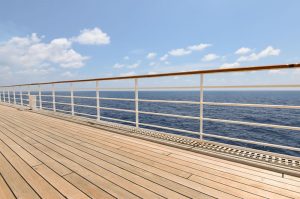
At least until you get your sea legs . Watching the horizon (but not constantly staring at it) will help your senses stay in tune with each other.
The fresh air will also feel nice and relaxing.
If you do go in the cabin, try to stick around places with windows.
4. Don’t Cruise on Small Vessels
The smaller they are, the more movement you will feel . Smaller ships are also less likely to have stabilizers, so your chances of getting motion sickness on a smaller vessel are higher than on a larger one.
Stick with big cruise ships for a pleasant vacation.
5. Eat the Right Foods

Cruise ships are well known for their wide selection of luxurious foods , but if you’re worried about motion sickness, a lot of those foods are probably things you should avoid .
Eat light meals that avoid fatty foods, sugar, and too much salt. You may also want to hold off on the alcohol, at least for the first day or two.
If your stomach does end up feeling upset, ginger, saltine crackers, and green apples are natural foods that will soothe your stomach. Some cruise ships actually offer these foods on their room service menus.
6. Keep the Cruise Short
If you aren’t an experienced cruiser, you should test out a few short cruises first , cruises that are only two or three days long.
This will give you a chance to experience a cruise, but you won’t be stuck on board for multiple days if things go bad.
Another way to test the waters is to find cruises that have a lot of opportunities to port and get off the ship. This will give you a break from the constant rocking of the waves.
7. Don’t Ruin It for Yourself
If you are worried about getting motion sickness on a cruise and are constantly stressing about it, odds are you’ll get it.
The mind is very powerful , and it can make you feel motion sickness even if you wouldn’t have naturally felt it.
This is especially true if you experience motion sickness during car rides, plane rides, carnival rides, and train rides. Your stress of past motion sickness can actually make you get motion sickness again.
Don’t Stress About It
So don’t work yourself up. If you start to notice signs of motion sickness on a cruise, address them right away before they have a chance to get worse.
This means going to the deck if you’re in the cabin, putting down your book, or choosing healthier, lighter meals.
Ready for your next cruise? Check out some of our cruise excursions !
- Cruise Ships
- Ports of Call
- Travel Tips

GOING ON CRUISE ?
Book now hotels, flights, cars , tours and more ...
Privacy Overview
Pin it on pinterest.
Do you really need a motion sickness patch for your cruise?

You've boarded your first cruise and spy lots of your shipmates sporting a patch behind their ears. Why are they wearing this? Does it improve their cruise experience? What do all those people know that you don't?
Those little circular patches you see behind the ears of so many cruisers are most likely a prescription drug called scopolamine transdermal system. It is often prescribed for situational nausea and vomiting after surgery. However, it is also useful for motion sickness, as you might experience on board cruise ships. The medication contained in the patch is slowly released into the wearer's system over the course of three days. It works through the central nervous system to calm the digestive system.
Now that you know, you might develop a case of FOMO. Should you have asked your doctor for patches for your cruise? When I mentioned the patches to my primary care physician (a fellow cruiser), her response was quick and a bit snarky, "What is up with everybody thinking they need scopolamine patches to go on a cruise?"
She explained that she sees many people with no history of motion sickness who want them. However, she cautions they aren't for everyone.
For cruise news, reviews and tips, sign up for TPG's cruise newsletter .
After talking with my doctor, I did further research on prescription motion sickness patches for cruising. Here's what I learned about whether you really need that scopolamine patch — or if you're better off without it.
You might not need a patch to weather your cruise
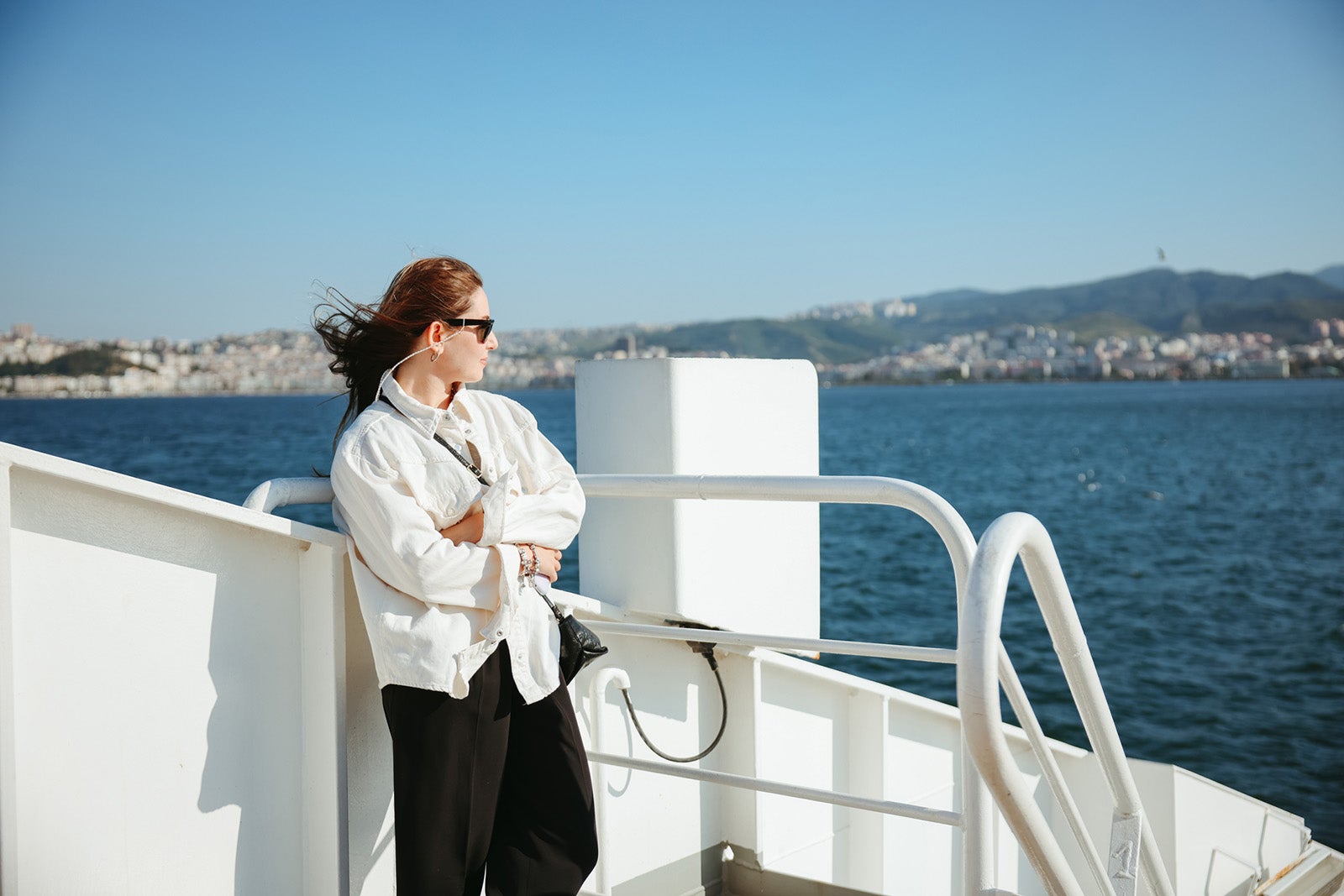
Motion sickness is a possibility on a cruise ship, but don't assume you will experience it on your sailing. Most large ships are stabilized to prevent excessive motion, and the average cruise (especially to popular destinations in the Bahamas and the Caribbean) takes place in calm waters.
Also, some people are more prone to seasickness than others. If you frequently ride roller coasters and don't have trouble on airplanes no matter how turbulent, or if you can sit in the backseat of a car on a winding mountain road, you probably aren't prone to feeling nauseated from movement.
For many people who do feel ill on a cruise, motion sickness is a limited-time event. It might hit you during the first 24 hours of sailing, quickly calming down as your nervous system adapts to the motion. Symptoms might only affect you when the exact set of circumstances appears that disturbs your equilibrium enough to cause nausea. They may then disappear as soon as the ship rights itself, so to speak, or when you head to the more stable lower decks and gaze out at the horizon.
In this case, too, wearing a patch for the duration of the cruise is not warranted.
Still, there are some people who will become ill just reading about rocking ships or turbulent flights and are extremely nervous about heading out to sea on a boat. If that's you, patches for the duration of any cruise are something you might consider.
Related: How to avoid seasickness on your next cruise
Not everyone can use scopolamine patches
The active medication in the patches can interact with some other medications. It's a long list and includes common over-the-counter medications like Benadryl. You, your doctor and your pharmacist should carefully evaluate your potential for medication conflicts if you plan to use motion sickness patches during your cruise.
Also, patches aren't the only seasickness remedy you can try. Some people use over-the-counter medication tablets, such as Dramamine or Bonine. You can also try alternatives to medicine like acupressure bands for your wrists or settle your stomach with foods such as green apples, ginger ale or ginger candies, and crackers.
Related: How to avoid getting sick on a cruise
The patches can have surprising side effects
A motion-sickness patch may look innocuous. However, it is still a prescription medication and can have adverse side effects not to be taken lightly. Consider the possibility of ill effects before you commit to the patch on your next cruise.
For example, I met a woman who put on a patch during her first cruise. She discovered several hours later, as she was putting makeup on that the pupil in one of her eyes was fully dilated — the eye on the side where her patch was placed. She thought she was having a stroke. She contacted her physician, who advised her to immediately remove the patch. The dilation subsided, and all was well for the remainder of her cruise.
She had not experienced any seasickness before using the patch nor after removing it. She had simply taken a proactive approach, just in case. Her medical chart now includes her reaction with a note that she cannot use scopolamine. She does, however, intend to cruise again and hopes her lack of motion sickness on her first cruise will hold true in the future.
Other side effects of the patches include dry mouth, dizziness, drowsiness and even disorientation. Also, a big problem for many cruisers is that you should not consume alcohol while wearing the patch. Doing so intensifies the side effects, especially drowsiness and dizziness.
Related: Do cruise ships have doctors, nurses, medical centers or hospitals?
Patches can be useful in rough seas

Although ship captains aim to avoid dangerously rough seas, cruise ships are designed to handle far larger waves than one might think. That means choppy rides may occur. You'll know rough seas are ahead when you see motion-sickness bags strategically placed in the stairwells.
Scopolamine patches can be useful on any cruise with the potential for large waves, such as hurricane season sailings, transatlantic crossings and cruises through notoriously rough waters, such as the Drake Passage on the way to Antarctica. If you're nervous about feeling ill during any of these sailings, that is the perfect time to talk to your doctor about a prescription for patches.
Related: What to do if you find yourself on a wildly tilting cruise ship
If you are prone to motion sickness in general, talk to your doctor about prescription patches. My physician said she wouldn't have a problem prescribing the patches for someone going on their first cruise if they don't have conflicting medications or conditions and understand that there are side effects.
There are a few itineraries and seasons for which even the most sea-hardy among us might proactively take along a supply of patches. It's better to be prepared and not need them than to suffer through a rough ride without any relief.
If you have successfully worn scopolamine patches in the past without side effects, consider only wearing one the first 24 hours of the cruise or when rough seas are expected.
Bottom line
If you've never cruised but generally don't experience motion sickness, don't assume you'll need seasickness medication for your first sailing. You might be surprised that a cruise ship's ride is much smoother than you thought.
However, if you're worried motion-induced nausea may sideline you during your cruise, talk to your doctor about the best motion sickness medications before you sail.
Planning a cruise? Start with these stories:
- The 5 most desirable cabin locations on any cruise ship
- A beginners guide to picking a cruise line
- The 8 worst cabin locations on any cruise ship
- The ultimate guide to what to pack for a cruise
- A quick guide to the most popular cruise lines
- 21 tips and tricks that will make your cruise go smoothly
- 15 ways cruisers waste money
- The ultimate guide to choosing a cruise ship cabin
Appointments at Mayo Clinic
- Motion sickness: First aid
Any type of transportation can cause motion sickness. It can strike suddenly, progressing from a feeling of uneasiness to a cold sweat, dizziness and vomiting. It usually quiets down as soon as the motion stops. The more you travel, the more easily you'll adjust to being in motion.
You might avoid motion sickness by planning ahead. When traveling, avoid sitting in the rear of the vehicle or in seats that face backward. Pick seats where you'll feel motion least:
- By ship, request a cabin in the front or middle of the ship near the water level.
- By plane, ask for a seat over the front edge of a wing. Once aboard, direct the air vent flow to your face.
- By train, take a forward-facing seat near the front and next to a window.
- By automobile, drive or sit in the front passenger's seat. Children should be in age-appropriate seats and restraints.
If you're susceptible to motion sickness:
- Focus on the horizon or on a distant, stationary object. Don't read or use electronic devices while traveling.
- Keep your head still, while resting against a seat back.
- Don't smoke and don't sit near smokers.
- Avoid strong odors, spicy and greasy foods, and alcohol.
- Take an antihistamine, which you can buy without a prescription. Medicines include dimenhydrinate (Dramamine, Driminate, others) and meclizine (Dramamine Less Drowsy, Travel-Ease, others). Dimenhydrinate is safe for children older than age 2. Take these medicines at least 30 to 60 minutes before you travel. Expect drowsiness as a side effect.
- Consider scopolamine, available in a prescription adhesive patch called Transderm Scop. Several hours before you plan to travel, apply the patch behind your ear for 72-hour protection. Talk to your health care provider before using the medicine if you have health problems such as glaucoma or urine retention.
- Try ginger. A ginger supplement combined with ginger snaps, ginger ale or candied ginger might help curb nausea.
- Eat lightly. Some people find that nibbling on plain crackers and sipping cold water or a carbonated drink without caffeine help.
- Ferri FF. Motion sickness. In: Ferri's Clinical Advisor 2023. Elsevier; 2023. https://www.clinicalkey.com. Accessed Nov. 29, 2022.
- Bennett JE, et al. Protection of travelers. In: Mandell, Douglas, and Bennett's Principles and Practice of Infectious Diseases. 9th ed. Elsevier; 2020. https://www.clinicalkey.com. Accessed Nov. 29, 2022.
- Priesol AJ. Motion sickness. https://www.uptodate.com/contents/search. Accessed Nov. 29, 2022.
- Motion sickness. Centers for Disease Control and Prevention. https://wwwnc.cdc.gov/travel/page/motion-sickness. Accessed Nov. 29, 2022.
- Kc Leung A, et al. Motion sickness: An overview. Drugs in Context. 2019; doi:10.7573/dic.2019-9-4.
- Dimenhydrinate oral. Facts & Comparisons eAnswers. https://fco.factsandcomparisons.com. Accessed Nov. 29, 2022.
Products and Services
- A Book: Mayo Clinic Book of Home Remedies
Mayo Clinic does not endorse companies or products. Advertising revenue supports our not-for-profit mission.
- Opportunities
Mayo Clinic Press
Check out these best-sellers and special offers on books and newsletters from Mayo Clinic Press .
- Mayo Clinic on Incontinence - Mayo Clinic Press Mayo Clinic on Incontinence
- The Essential Diabetes Book - Mayo Clinic Press The Essential Diabetes Book
- Mayo Clinic on Hearing and Balance - Mayo Clinic Press Mayo Clinic on Hearing and Balance
- FREE Mayo Clinic Diet Assessment - Mayo Clinic Press FREE Mayo Clinic Diet Assessment
- Mayo Clinic Health Letter - FREE book - Mayo Clinic Press Mayo Clinic Health Letter - FREE book
Your gift holds great power – donate today!
Make your tax-deductible gift and be a part of the cutting-edge research and care that's changing medicine.
You are using an outdated browser. Upgrade your browser today or install Google Chrome Frame to better experience this site.
Motion Sickness
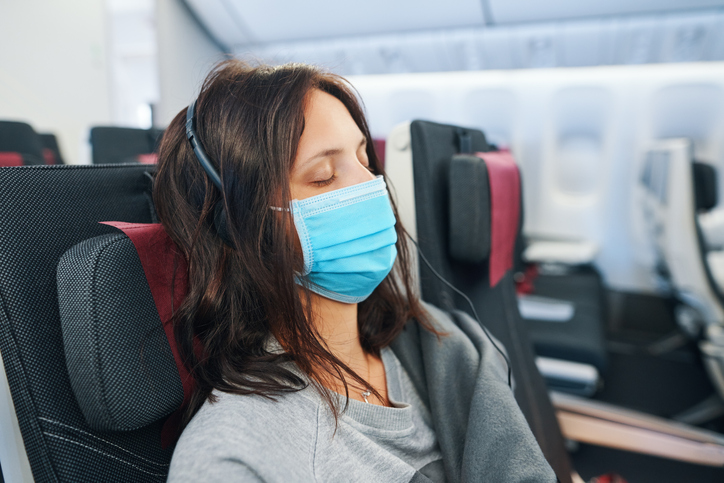
Motion sickness happens when the movement you see is different from what your inner ear senses. This can cause dizziness, nausea, and vomiting. You can get motion sick in a car, or on a train, airplane, boat, or amusement park ride. Motion sickness can make traveling unpleasant, but there are strategies to prevent and treat it.
Preventing motion sickness without medicine
Avoiding situations that cause motion sickness is the best way to prevent it, but that is not always possible when you are traveling. The following strategies can help you avoid or lessen motion sickness.
- Sit in the front of a car or bus.
- Choose a window seat on flights and trains.
- If possible, try lying down, shutting your eyes, sleeping, or looking at the horizon.
- Stay hydrated by drinking water. Limit alcoholic and caffeinated beverages.
- Eat small amounts of food frequently.
- Avoid smoking. Even stopping for a short period of time helps.
- Try and distract yourself with activities, such as listening to music.
- Use flavored lozenges, such as ginger candy.
Using medicines for motion sickness
Medicines can be used to prevent or treat motion sickness, although many of them cause drowsiness. Talk to a healthcare professional to decide if you should take medicines for motion sickness. Commonly used medicines are diphenhydramine (Benadryl), dimenhydrinate (Dramamine), and scopolamine.
Special Consideration for Children

Motion sickness is more common in children ages 2 to 12 years old.
Some medicines used to prevent or treat motion sickness are not recommended for children. Talk to your healthcare professional about medicines and correct dosing of medicines for motion sickness for children. Only give the recommended dosage.
Although motion sickness medicines can make people sleepy, it can have the opposite effect for some children, causing them to be very active. Ask your doctor if you should give your child a test dose before traveling.
More Information
Motion Sickness in CDC Yellow Book
File Formats Help:
- Adobe PDF file
- Microsoft PowerPoint file
- Microsoft Word file
- Microsoft Excel file
- Audio/Video file
- Apple Quicktime file
- RealPlayer file
- Zip Archive file
Exit Notification / Disclaimer Policy
- The Centers for Disease Control and Prevention (CDC) cannot attest to the accuracy of a non-federal website.
- Linking to a non-federal website does not constitute an endorsement by CDC or any of its employees of the sponsors or the information and products presented on the website.
- You will be subject to the destination website's privacy policy when you follow the link.
- CDC is not responsible for Section 508 compliance (accessibility) on other federal or private website.

How to avoid seasickness on your next cruise
MSN has partnered with The Points Guy for our coverage of credit card products. MSN and The Points Guy may receive a commission from card issuers.
Will I get seasick if I go on a cruise? That question was, unfortunately, not something I asked myself when I packed for my first ever sailing to Greece. And that ship rocked. It bounced. It rolled over the waves in a way that made my stomach feel like a water bottle being spun round and round.
As I approached the windy shores of Mykonos, I wondered how I could be so unprepared to feel so queasy — and desperately wished for some magic potion that would make my motion sickness go away.
Luckily, that first Greece cruise didn’t dissuade me from setting sail. I love being on a boat. I even got married on a yacht in the New York Harbor. And my sea legs are usually pretty strong.
However, as every seasoned traveler knows, being prepared is the most important part of travel. Even those of us not prone to mal-de-mer can find ourselves in storms and rough waters that bring on those unpleasant queasy feelings. If you can’t avoid seasickness on your sailing, you can at least be ready to minimize its ill effects.
In my attempt to seek out the best remedy for seasickness on a cruise, I reached out to Dr. Jenny Yu of Healthline (a subsidiary of TPG’s parent company Red Ventures). She offered in-depth guidance on how to prevent seasickness on a cruise, along with great tips on how to keep your stomach from flip-flopping should the waves start rocking and rolling on future journeys.
For more cruise news, reviews and tips, sign up for TPG’s free cruise newsletter .
What are the symptoms of seasickness?
Seasickness, mal-de-mer, motion sickness: It’s all the same thing. It’s that funny feeling in your stomach and cloudiness or dizziness in your head that can sometimes turn to nausea when you’re traveling by car, plane, train, bus or boat.
When suffering from seasickness on a cruise, you could just feel a bit “off,” start to feel sick to your stomach or, in its worse form, vomit. You may also feel like you’ve lost your sense of balance and stumble a bit as you walk around the ship.
Related: 21 tips and tricks that will make your first cruise go smoothly
What causes seasickness?
“Motion sickness, in general, is caused by conflicting signals that are sent to the brain by the eyes, ears and our neuromuscular system,” said Dr. Yu. “Our eyes and ears (the vestibular system) senses motion while our neuromuscular system senses stillness. When these signal systems send conflicting information to the brain, it can cause the symptoms of dizziness, nausea, irritability, fatigue, sweating and inability to concentrate.”
Dr. Yu says this can happen not only while you are on a ship, but also in a car, plane or train or even playing VR and/or video games.
We get seasick when our sense of motion and balance get out of sync. When your ship starts sailing, it will transfer motion to you. If you’re inside and away from a window, you’re not seeing the motion, but you’re feeling it. This creates a dissonance that can be problematic for your body.
Related: Tips for avoiding motion sickness while traveling
Who’s at risk to suffer from seasickness?
Some people are more prone to seasickness than others and doctors can’t explain why. But they do know that children ages 2 to 12 are more apt to suffer from the illness, as are pregnant women. Therefore, it’s more important for those groups to try to avoid getting seasick in the first place.
How to prevent and treat seasickness
How do you prevent seasickness on a cruise so you don’t have to feel ill and treat the symptoms? Old salts will give you all sorts of tips to avoid getting sick while at sea. These are TPG’s favorites:
Spend time on deck as the ship gets underway
Once your cruise ship has set sail from its embarkation port, you might feel compelled to go explore the ship or relax in your room. Resist the urge; instead, spend some time on an open deck, watching the horizon. This “helps the eyes visually process movement,” says Dr. Yu.
Give your eyes, body and brain a chance to “sync up.” As you feel the ship moving through the water, and see the horizon bob in the distance, your brain can “reprogram” its sense of balance and normalcy. This helps a lot. Just be sure to sit parallel to the horizon or face the same direction as the ship’s movement. You don’t want to face the opposite direction — that can confuse your sensory inputs.
If you are somewhere inside the ship and start feeling sick at any point during the voyage, head right to an open deck for some fresh air as you train your eyes on the horizon. It will give your brain a chance to correctly interpret the signals it’s receiving from all your senses.
Pick a big ship
How much you feel the ocean’s movement will depend on the type of ship you’re sailing. The smaller the ship, the more movement you’ll feel.
To minimize the risk of seasickness, book one of the world’s largest ships, such as Royal Caribbean’s Wonder of the Seas . Keep in mind that the ocean is much larger than even the most gargantuan ships, so when the seas are rough, you can still feel movement — just less than if you’re sailing on a 100-person yacht.
Related: What to do if you find yourself on a wildly tilting cruise ship
Pick the right cabin
If you’re worried about seasickness, pick a cabin that’s as close to the water level as possible and in the center of the ship. You’ll be at the ship’s fulcrum point, which means you’ll feel less movement than people on higher decks with cabins far forward or all the way at the back.
Spring for a room with a view of the water, or with outdoor space if possible, says Dr. Yu, so you can easily keep an eye on the horizon and have quick access to fresh air.
Related: The 5 best cabin locations on any cruise ship
Select the right itinerary
If you think you’ll be plagued by seasickness, pick an itinerary with more time spent in port and fewer days spent entirely at sea.
Also, consider a voyage that sails calm waters. For example, Alaska Inside Passage voyages , sailing round-trip from Seattle or Vancouver, are known to be smooth sailing most of the time; one-way itineraries that cross the Gulf of Alaska can be rockier. River cruises excel at offering slow travel without swells and with frequent port stops.
Avoid cruise regions with a reputation for rockiness, such as the Pacific Ocean or the Drake Passage between South America and Antarctica.
Related: 8 cabin locations on cruise ships that you definitely should avoid
Eat and drink the right things
On embarkation day, it’s smart to eat balanced meals and avoid anything greasy or acidic (so skip that burger and fries or an Italian feast on the first day of your cruise). Also, avoid alcohol. Anything that causes dehydration can be a trigger for seasickness.
Don’t skip meals altogether, though. It’s important to have food in your stomach at the beginning of your cruise. Dr. Yu suggests choosing carbonated beverages to accompany a light meal to help with feelings of nausea.
After the first day at sea, you should be able to resume your normal eating and drinking habits. Dr. Yu also recommends taking antihistamines (such as Claritin or Alavert) at the start of the cruise, which can be helpful when setting sail.
Related: 5 reasons you should splurge on a cruise ship specialty restaurant
Natural remedies may work
If you do start feeling off, you don’t necessarily need to medicate. While natural remedies can’t treat all symptoms of seasickness, says Dr. Yu, lemon, green apple, ginger and peppermint all have anecdotal evidence of treating nausea.
Personally, I’m a fan of peppermint tea and ginger chews, which I now always pack for cruise vacations. Many cruise ship main dining rooms set out a bowl of ginger in the reception area.
Dr. Yu also suggests one of my favorite natural seasickness remedies — acupressure wristbands. These are wristbands that apply directed pressure to a particular point on the inside of your wrist that is known for reducing nausea.
Finally, don’t rule out shut-eye as a cure-all. “Sleep is beneficial for helping with vertigo and dizziness,” advised Dr. Yu.
Related: How to book a cruise using points and miles
Medications
If all of the precautions above don’t stop the onset of seasickness symptoms, it’s time to take medications, says Dr. Yu.
Dramamine (dimenhydrinate, an antiemetic), scopolamine (a patch that you affix behind your ear for up to three days) and antihistamines are all medications that can help when you’re treating motion or seasickness.
Many cruisers pack over-the-counter Bonine or Antivert, which are just the brand name for the antihistamine meclizine. Your doctor can also provide a prescription for meclizine that you can get filled at your pharmacy. Benadryl (diphenhydramine) also works for some people.
The key with these drugs is to take the first pill about an hour before the ship starts moving.
Not all antihistamines reduce the symptoms of motion sickness, so if you pack one, be sure it will work for this purpose. Talk with your doctor to pick the best option for you and your family.
Note that there can be side effects — like dry mouth and drowsiness — with each of these drugs.
You’ll want to bring seasickness prevention products from home, so be sure to pack them in your travel first-aid kit. Some cruise lines will give out certain remedies at the reception desk for free, but if you need to buy them at the onboard boutique, be ready to pay an inflated price.
If you get very sick, make an appointment with the ship’s doctor, who may give you any of the above drugs or promethazine (a combined antihistamine and antiemetic) or ephedrine.
Your regular health insurance will not cover visits to the ship’s doctor or prescriptions obtained on board; you’ll need to pay out of pocket and file a claim with your regular or travel insurance when you return home.
Bottom line
Don’t let the worry of seasickness stop you from booking a cruise. Many travelers have gone on dozens of voyages and never had an issue.
Even if you do experience motion sickness on board, there are plenty of methods to stop that funny feeling in its tracks. Just board your ship prepared with some of the suggestions above, and you’ll be ready for a great cruise.
Planning a cruise? Start with these stories:
- The 5 most desirable cabin locations on any cruise ship
- A beginners guide to picking a cruise line
- The 8 worst cabin locations on any cruise ship
- A quick guide to the most popular cruise lines
- 21 tips and tricks that will make your cruise go smoothly
- 15 ways cruisers waste money
- 12 best cruises for people who never want to grow up
- What to pack for your first cruise
Additional reporting by Andrea Rotondo.
SPONSORED: With states reopening, enjoying a meal from a restaurant no longer just means curbside pickup.
And when you do spend on dining, you should use a credit card that will maximize your rewards and potentially even score special discounts. Thanks to temporary card bonuses and changes due to coronavirus, you may even be able to score a meal at your favorite restaurant for free.
These are the best credit cards for dining out, taking out, and ordering in to maximize every meal purchase.
Editorial Disclaimer: Opinions expressed here are the author’s alone, not those of any bank, credit card issuer, airlines or hotel chain, and have not been reviewed, approved or otherwise endorsed by any of these entities.

Thanks for visiting! GoodRx is not available outside of the United States. If you are trying to access this site from the United States and believe you have received this message in error, please reach out to [email protected] and let us know.

IMAGES
COMMENTS
The Seasickness Patch: One of the Strongest Motion Sickness Remedies. ... gadgets and natural remedies like ginger. A little pre-cruise homework can go a long way in keeping seasickness at bay.
Seasickness is a form of motion sickness that occurs when there is a discrepancy between the motion of the ship, visual input, and the vestibular system in your inner ear. Essentially, the body's balance mechanism becomes disoriented. The rocking motion of the ship confuses your body's senses into becoming imbalanced.
As a recap, these are the most effective and recommended seasickness medications and natural remedies for a cruise (all Amazon links). Seabands (for adults) Seabands (for children) Bonine. Dramamine (long lasting nausea relief) Dramamine for kids (see choices on Amazon) Ginger candies. Motion sickness patches.
Advertisement. After a few months of therapy, most people feel better and the persistent motion sensation no longer bothers them. However, another cruise — or whatever activity triggered mal de ...
Here are some of the best remedies for tackling motion sickness on a cruise. Bring Nausea Relief. If you're more sensitive to motion sickness on cruises, stay prepared with store-bought solutions. Some of the most popular products include skin patches and wristbands. Patches are typically placed behind your ear where the medication can more ...
I've gotten seasick on a 2,000-passenger cruise ship in the Caribbean. I've gotten sick on the 100-car auto-ferry that putters sturdily from Lewes, Delaware, to Cape May, New Jersey. I got sick while snorkeling on gentle waves in Baja Mexico, on both a Jetski and a pontoon boat on a tiny lake in Michigan, and even, somehow, while rocking ...
Natural Remedies for Motion Sickness. If you're looking for natural remedies to help ease your motion sickness after a cruise, there are several options to consider. These remedies can help alleviate symptoms like nausea, dizziness, and vomiting. 1. Ginger. One of the most popular natural remedies for motion sickness is ginger.
To reduce motion sickness, choose a stateroom in the middle of the ship on a lower deck. You will feel any sway of the ship less in this section. Although it may seem counterintuitive, if you're worried about seasickness on a cruise, book a stateroom with a window or a veranda. Fresh air access and a horizon view will help alleviate ...
Motion sickness can put a damper on your cruise experience, but fortunately, there are several effective medications available to help alleviate its symptoms. When it comes to choosing the best motion sickness medicine for cruises, a few options stand out. These include medications, seasickness patches, Sea-Bands, and even specific cabin choices that can help alleviate motion sickness.
5. Eat the Right Food. Eating the right foods is one of the best ways to avoid seasickness on a cruise ship . Stay clear of heavy, greasy meals that can upset your stomach and make you more ...
Herbal cures for motion sickness. If you're searching for natural remedies for motion sickness, Robins says ginger may help. Ginger has historically been used to treat nausea. The natural herb is especially popular with pregnant women suffering from morning sickness. If feeling nauseous at sea, try fighting that queasiness with ginger, which is ...
Dehydration will worsen motion sickness symptoms, so pack a water bottle that you can refill and have with you at all times while on the ship, WebMD advises. By the same token, avoid packing or consuming anything with caffeine or alcohol, as these have a dehydrating effect. According to Healthline, putting pressure on an acupressure point along ...
Holland America guests can dial the emergency number on their cabin phone 24 hours a day for medical assistance. Azamara's medical centers are open twice a day for walk-ins. If you need to see someone during off hours, guest services can call an on-duty nurse. On a Carnival Cruise Line ship, medical staff is on call 24 hours a day for ...
2. Pick the Right Room. A lot of big cruise ships have things called stabilizers, little "wings" that extend off the bottom of the ship under the water, to keep them upright.This means less rocking and less chance of getting motion sickness. Low, center rooms are the closest to the stabilizers. If you are worried about motion sickness, these rooms will be the best for you.
Drink plenty of water and avoid caffeine and alcohol. Eat light meals: Avoid eating heavy meals before and during the cruise. Eat small, frequent meals that are easy to digest. Avoid reading and watching TV: Reading and watching TV can make motion sickness worse. Try to focus on other activities, such as talking to people or playing games.
It happens most often after you've been out on the ocean, but riding in planes, trains, and cars can lead to it, too. It's even been caused by water beds, elevators, walking on docks, and ...
Motion Sickness. Motion sickness is a common condition that happens when you're in motion, like riding in a vehicle, while sitting still. It happens when your eyes, inner ear and body send conflicting messages to your brain. Symptoms include nausea, breaking out in cold sweat or headache. Fortunately, there are ways to prevent motion sickness ...
Here are my tips for using the motion sickness patch. This is just what I did, I'm not a medical professional, so make sure to talk to your prescribing doctor. Put the patch on prior to setting sail. I put my patch on around 8am, and our ship set sail at 4pm. After applying the patch, wash your hands immediately.
Motion sickness is a possibility on a cruise ship, but don't assume you will experience it on your sailing. Most large ships are stabilized to prevent excessive motion, and the average cruise (especially to popular destinations in the Bahamas and the Caribbean) takes place in calm waters. Also, some people are more prone to seasickness than others.
Any type of transportation can cause motion sickness. It can strike suddenly, progressing from a feeling of uneasiness to a cold sweat, dizziness and vomiting. It usually quiets down as soon as the motion stops. The more you travel, the more easily you'll adjust to being in motion. You might avoid motion sickness by planning ahead.
Motion Sickness. Motion sickness happens when the movement you see is different from what your inner ear senses. This can cause dizziness, nausea, and vomiting. You can get motion sick in a car, or on a train, airplane, boat, or amusement park ride. Motion sickness can make traveling unpleasant, but there are strategies to prevent and treat it.
Give your eyes, body and brain a chance to "sync up.". As you feel the ship moving through the water, and see the horizon bob in the distance, your brain can "reprogram" its sense of ...
Scopolamine (Transderm Scop) is a motion sickness patch that's applied behind your ear. Once you've applied a patch, it lasts for up to 3 days. This makes the patch a helpful option for long-term relief, such as sea sickness on a cruise. But unlike motion sickness pills, the patches are only available with a prescription.